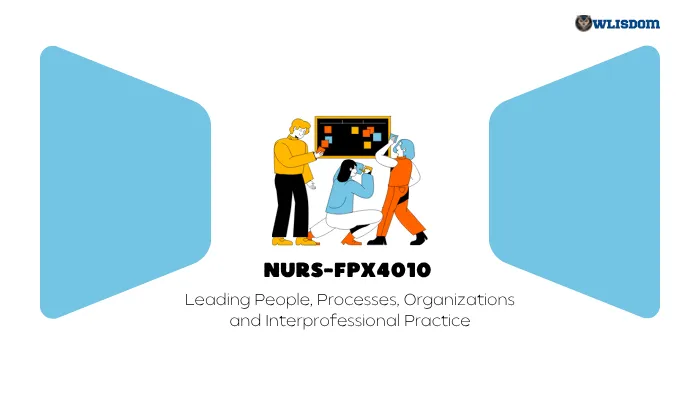NURS-FPX4010 – Leading People, Processes, and Organizations in Interprofessional Practice
Published: 2025-10-16
Modified: 2025-10-16
Samples Solutions
Introduction:
NURS-FPX4010 focuses on developing leadership and management skills in interprofessional healthcare settings. Students will explore strategies for leading teams, coordinating processes, and optimizing organizational efficiency. For expert guidance with assignments related to interprofessional practice, visit Owlisdom’s Nursing Assignment Help.
NURS-FPX4010 Assessment 1 Collaboration and Leadership Reflection Video
Instructions of NURS-FPX4010 Assessment 1
Introduction
Interprofessional collaboration is a critical aspect of a nurse’s work. Through interprofessional collaboration, practitioners and patients share information and consider each other’s perspectives to better understand and address the many factors that contribute to health and well-being (Sullivan et al., 2015). Essentially, by collaborating, healthcare practitioners and patients can have better health outcomes. Nurses, who are often at the frontlines of interacting with various groups and records, are full partners in this approach to health care.
Reflection is a key part of building interprofessional competence, as it allows you to look critically at experiences and actions through specific lenses. From the standpoint of interprofessional collaboration, reflection can help you consider potential reasons for and causes of people’s actions and behaviors (Saunders et al., 2016). It can also provide opportunities to examine the roles team members adopted in a given situation as well as how the team could have worked more effectively.
As you begin to prepare this assessment, you are encouraged to complete the What is Reflective Practice? activity. The activity consists of five questions that will allow you the opportunity to practice self-reflection. The information gained from completing this formative will help with your success on the Collaboration and Leadership Reflection Video assessment. Completing formatives is also a way to demonstrate course engagement
Note: The Example Kaltura Reflection demonstrates how to cite sources appropriately in an oral presentation/video. Your assessment will reflect on either a professional collaboration you experienced or a collaboration case study scenario that you imagine you experienced
References
Saunders, R., Singer, R., Dugmore, H., Seaman, K., & Lake, F. (2016). Nursing students’ reflections on an interprofessional placement in ambulatory care. Reflective Practice, 17(4), 393–402.
Sullivan, M., Kiovsky, R., Mason, D., Hill, C., Duke, C. (2015). Interprofessional collaboration and education. American Journal of Nursing, 115(3), 47–54.
Demonstration of Proficiency
- Competency 1: Explain strategies for managing human and financial resources to promote organizational health.
- Identify how poor collaboration can result in inefficient management of human and financial resourReflect on an interdisciplinary collaboration experience supported by evidence from the literature.
- Competency 2: Explain how interdisciplinary collaboration can be used to achieve desired patient and system outcomes.
- thinking ways in which it was successful and unsuccessful in achieving desired outcomes.
- Identify best-practice interdisciplinary collaboration strategies to help a team to achieve its goals and work more effectively together.
- Competency 4: Explain how change management theories and leadership strategies can enable interdisciplinary teams to achieve specific organizational goals.
- Identify best-practice leadership strategies from the literature that would improve an interdisciplinary team’s ability to achieve its goals.
- Competency 5: Apply professional, scholarly, evidence-based communication strategies to impact patient, interdisciplinary team, and systems outcomes.
- Communicate via video with clear sound and light.
- The full reference list is from relevant and evidence-based (published within 5 years) sources, exhibiting nearly flawless adherence to APA format.
Professional Context
This assessment will help you to become a reflective practitioner. By considering your own successes and shortcomings in interprofessional collaboration, you will increase awareness of your problem-solving abilities. You will create a Kaltura video of your reflections, including a discussion of best practices for interprofessional collaboration and leadership strategies, supported by references to the literature.
You may choose to reflect on a collaborative interprofessional project you worked on in your current or former place of practice, or you may choose to imagine that you worked on the collaborative interprofessional scenario presented in the Assessment 01 Supplement: Collaboration and Leadership Reflection Video [PDF] resource.
Scenario
As part of an initiative to build effective collaboration at a site where you work as a nurse, you have been asked to:
- Reflect on an interprofessional collaborative project.
- Examine what happened during the collaboration.
- Identify positive aspects and areas for improvement.
- Research best practices for interprofessional collaboration.
- Use lessons learned from your research and experience to create a video reflection (5-10 minutes) that shares suggestions for improving interprofessional collaboration that can be shared with leadership and colleagues.
Instructions
Using Kaltura, record a video (5–10 minutes) where you reflect on an interprofessional collaboration experience, proposing recommendations for how to improve interprofessional collaboration that can be shared with leadership and colleagues. Support these recommendations with references to the literature.
The interprofessional project that you reflect on may be one that you collaborated on at your current or former place of practice, or you may choose to imagine you collaborated on the interprofessional project presented in the Assessment 01 Supplement: Collaboration and Leadership Reflection Video [PDF] Download Assessment 01 Supplement: Collaboration and Leadership Reflection Video [PDF]resource and reflect on that.
Be sure that your assessment addresses the following criteria. Please study the scoring guide carefully so you will know what is needed for a distinguished score:
- Reflect on an interdisciplinary collaboration experience, noting ways in which it was successful and unsuccessful in achieving desired outcomes.
- Explain aspects of the collaboration that helped the team make progress toward relevant goals or outcomes.
- Explain aspects of the collaboration that could have been improved.
- Identify how poor collaboration can result in inefficient management of human and financial resources, citing supporting evidence from the literature.
- Discuss the ways in which the interdisciplinary team did not collaborate effectively.
- Discuss the negative implications for the human and financial resources of the interdisciplinary team and the organization as a whole.
- Cite the literature for support.
- Identify best-practice leadership strategies from the literature that would improve an interdisciplinary team’s ability to achieve its goals, citing at least one author from the literature.
- Identify at least one leadership best practice or strategy that you believe would improve the team’s ability to achieve its goals.
- Identify the strategy and its source or author, and provide a brief rationale for your choice of strategy.
- Cite the literature for support.
- Identify best-practice interdisciplinary collaboration strategies to help a team achieve its goals and work together, citing the work of at least one author.
- Identify at least one best practice or strategy for interdisciplinary collaboration to help the team achieve its goals and work more effectively together.
- Identify the strategy, its source, and the reasons why you think it will be effective.
- Communicate professionally, are easily audible, and use proper grammar. Format reference list in current APA style.
- Submit an APA-formatted reference list for any sources that you cited specifically in your video or used to inform your presentation.
- The Example Kaltura Reflection will show you how to cite scholarly sources in the context of an oral presentation.
Notes:
- Refer to the Campus tutorial Using Kaltura [PDF] as needed to record and upload your reflection.
- If, for some reason, you are unable to record a video, please contact your faculty member as soon as possible to explore options for completing the assessment.
Additional Requirements
- References: Cite at least 3 professional or scholarly sources of evidence to support the assertions you make in your video. Include additional properly cited references as necessary to support your statements.
- APA Reference Page: Submit a correctly formatted APA reference page that shows all the sources you used to create and deliver your video.
- You may wish to refer to the Campus APA Module for more information on applying APA style.
- Portfolio Prompt: Remember to save the final assessment to your ePortfolio so that you may refer to it as you complete the final Capstone course.
Competencies Measured
By successfully completing this assessment, you will demonstrate your proficiency in the following course competencies and scoring guide criteria:
- Competency 1: Explain strategies for managing human and financial resources to promote organizational health.
- Identify ways poor collaboration can result in inefficient management of human and financial resources, supported by evidence from the literature.
- Competency 2: Explain how interdisciplinary collaboration can be used to achieve desired patient and system outcomes.
- Reflect on an interdisciplinary collaboration experience, noting ways in which it was successful and unsuccessful in achieving desired outcomes.
- Identify best-practice interdisciplinary collaboration strategies to help a team to achieve its goals and work together more effectively.
- Competency 4: Explain how change management theories and leadership strategies can enable interdisciplinary teams to achieve specific organizational goals.
- Identify best-practice leadership strategies from the literature that would improve an interdisciplinary team’s ability to achieve its goals.
- Competency 5: Apply professional, scholarly, evidence-based communication strategies to impact patient, interdisciplinary team, and systems outcomes.
- Communicate via video with clear sound and light.
The full reference list is from relevant and evidence-based (published within 5 years) sources, exhibiting nearly flawless adherence to APA format.
Introduction to NURS-FPX4010 Assessment 1
The NURS-FPX4010 Assessment 1- Collaboration and Leadership Reflection Video focuses on interprofessional collaboration, which involves multiple health professionals from various fields working together to deliver the highest quality of care. This assignment focuses on reflecting on and analyzing a collaborative experience to identify successes, failures, and areas for improvement. The goal is to create a reflective video that can help enhance collaborative efforts within healthcare settings.
Reflect on an interprofessional collaborative project.
- Select a relevant project: Choose an interdisciplinary collaboration project you were involved in.
- Describe the setting and goals: Detail the context, objectives, and your role within the team.
- Use specific examples: Highlight key interactions and decision points in the collaboration.
Examine what happened during the collaboration.
- Team Communication: Describe how team members communicated throughout the project, including the frequency, methods (e.g., meetings, emails, instant messaging), and effectiveness of these communications.
- Decision-Making Processes: Analyze how decisions were made within the team. Highlight whether these were collaborative or if certain members dominated the decision-making process.
- Role Fulfillment: Evaluate whether each team member understood and fulfilled their assigned roles. Note any deviations from assigned responsibilities and how they impacted the collaboration.
- Conflict Management: Document any conflicts that arose and how they were resolved. Mention the strategies used for conflict resolution and their effectiveness.
- Project Milestones: Detail the major milestones achieved during the project and the collaborative efforts that led to these successes.
- Adaptation to Challenges: Describe how the team adapted to any unexpected challenges or changes in project scope, including the strategies implemented to manage these issues.
Identify positive aspects and areas for improvement.
- Highlight Strengths: Identify and emphasize the key strengths of the collaboration, such as effective communication channels, strong leadership, or innovative problem-solving approaches that contributed to achieving project goals.
- Pinpoint Weaknesses: Acknowledge specific areas where the collaboration fell short. This could include unclear role definitions, inadequate resource allocation, or a lack of timely decision-making.
- Recommend Enhancements: Based on the identified weaknesses, recommend specific improvements. Suggest practical strategies such as enhanced training for team members, better project management tools, or more structured meeting agendas to address these deficiencies.
Research best practices for interprofessional collaboration.
- Literature review: Conduct a thorough review of recent scholarly articles on interdisciplinary collaboration.
- Evidence-based strategies: Focus on finding proven strategies that enhance teamwork effectiveness.
- Cite sources: Ensure all sources are recent (within the last five years) and reputable.
Use lessons learned from your research and experience to create a video reflection (5-10 minutes) that shares suggestions for improving interprofessional collaboration that can be shared with leadership and colleagues.
- Integrate Key Insights: Summarize the most important lessons learned from both the research and your own experience regarding successful and unsuccessful aspects of collaboration. Emphasize practical strategies that could be implemented to enhance team dynamics and effectiveness.
- Propose Specific Improvements: Offer specific, actionable recommendations for improving interprofessional collaboration. These might include suggestions for better communication tools, conflict resolution strategies, or role clarification methods that can be easily adopted by your team and leadership.
- Encourage a Culture of Continuous Learning: Highlight the importance of ongoing education and reflection in fostering effective collaboration. Suggest regular review meetings or training sessions to discuss past collaborations and explore opportunities for improvement based on recent experiences and literature findings.
- Ensure the video has good lighting and clear audio.
- Practice your presentation to maintain a professional tone and pace.
Closing
The NURS-FPX4010 Assessment 1 Collaboration and Leadership Reflection Video provides a structured approach to critically analyzing interprofessional collaborations. By reflecting on past experiences, researching best practices, and effectively communicating findings, you can significantly contribute to the improvement of teamwork in healthcare settings. Remember, the competencies outlined are designed to guide your learning and application; they are not barriers but stepping stones to deeper understanding and professional growth.
The next NURS-FPX4010 Assessment 2 will focus on the “Interview and Interdisciplinary Issue Identification,” where you will conduct a 2–4 4-page report based on an interview with a health care professional.
NURS FPX 4010 Assessment 2 Interview and Interdisciplinary Issue Identification
Instructions for NURS-FPX 4010 Assessment 2
Interview and Interdisciplinary Issue Identification
For this assessment, you will create a 2–4 4-page report on an interview you have conducted with a health care professional. You will identify an issue from the interview that could be improved with an interdisciplinary approach, and review best practices and evidence to address the issue.
Collapse All
Introduction
As a baccalaureate-prepared nurse, your participation and leadership in interdisciplinary teams will be vital to the health outcomes of your patients and organization. One way to approach designing an improvement project is to use the Plan-Do-Study-Act (PDSA) cycle. The Institute for Healthcare Improvement describes it thus:
The Plan-Do-Study-Act (PDSA) cycle is shorthand for testing a change in the real work setting—by planning it, trying it, observing the results, and acting on what is learned. This is the scientific method adapted for action-oriented learning…Essentially, the PDSA cycle helps you test out change ideas on a smaller scale before evaluating the results and making adjustments before potentially launching into a somewhat larger-scale project (n.d.).
You might also recognize that the PDSA cycle resembles the nursing process. The benefit of gaining experience with this model of project design is that it provides nurses with an opportunity to ideate and lead improvements. For this assessment, you will not be implementing all of the PDSA cycle. Instead, you are being asked to interview a healthcare professional of your choice to determine what kind of interdisciplinary problem he or she is experiencing or has experienced in the workplace. This interview, in Assessment 2, will inform the research that you will conduct to propose a plan for interdisciplinary collaboration in Assessment 3.
It would be an excellent choice to complete the PDSA Cycle activity prior to developing the report. The activity consists of four questions that create the opportunity to check your understanding of best practices related to each stage of the PDSA cycle. The information gained from completing this formative will promote your success with the Interview and Interdisciplinary Issue Identification report. This will take just a few minutes of your time and is not graded.
Reference
Institute for Healthcare Improvement. (n.d.). How to improve. http://www.ihi.org/resources/Pages/HowtoImprove/default.aspx
Demonstration of Proficiency
- Competency 2: Explain how interdisciplinary collaboration can be used to achieve desired patient and system outcomes.
- Summarize an interview focused on past or current issues at a healthcare organization.
- Describe collaboration approaches from the literature that could be relevant in establishing or improving an interdisciplinary team to address an organizational issue.
- Competency 3: Describe ways to incorporate evidence-based practice within an interdisciplinary team.
- Identify an issue from an interview for which an evidence-based interdisciplinary approach would be appropriate.
- Competency 4: Explain how change management theories and leadership strategies can enable interdisciplinary teams to achieve specific organizational goals.
- Describe change theories and a leadership strategy that could help develop an interdisciplinary solution to an organizational issue.
- Competency 5: Apply professional, scholarly, evidence-based communication strategies to impact patient, interdisciplinary team, and systems outcomes.
- Organize content so ideas flow logically with smooth transitions; contain few errors in grammar/punctuation, word choice, and spelling.
- Apply APA formatting to in-text citations and references, exhibiting nearly flawless adherence to APA format.
Professional Context
This assessment will introduce the Plan-Do-Study-Act (PDSA) Model to create change in an organization. By interviewing a colleague of your choice, you will begin gathering information about an interprofessional collaboration problem that your colleague is experiencing or has experienced. You will identify a change theory and leadership strategies to help solve this problem.
Scenario
This assessment is the first of three related assessments in which you will gather interview information (Assessment 2); design a proposal for interdisciplinary problem-solving (Assessment 3); and report on how an interdisciplinary improvement plan could be implemented in a place of practice (Assessment 4). At the end of the course, your interviewee will have a proposal plan based on the PDSA cycle that he or she could present to stakeholders to address an interdisciplinary problem in the workplace.
For this assessment, you will need to interview a healthcare professional such as a fellow learner, nursing colleague, administrator, business partner, or another appropriate person who could provide you with sufficient information regarding an organizational problem that he or she is experiencing or has experienced, or an area where they are seeking improvements. Consult the Interview Guide [DOCX] Download Interview Guide [DOCX]for an outline of how to prepare and the types of information you will need to complete this project successfully.
Remember: this is just the first in a series of three assessments.
Instructions
For this assessment, you will report on the information that you collected in your interview, analyzing the interview data and identifying a past or current issue that would benefit from an interdisciplinary approach. This could be an issue that has not been addressed by an interdisciplinary approach or one that could benefit from improvements related to the interdisciplinary approach currently being used. You will discuss the interview strategy that you used to collect information. Your interview strategy should be supported by citations from the literature. Additionally, you will start laying the foundation for your Interdisciplinary Plan Proposal (Assessment 3) by researching potential change theories, leadership strategies, and collaboration approaches that could be relevant to the issue you have identified. Please be certain to review the scoring guide to confirm specific required elements of this assessment. Note that there are differences between basic, proficient, and distinguished scores.
When submitting your plan, use the Interview and Issue Identification Template [DOCX], and Download the Interview and Issue Identification Template [DOCX], which will help you to stay organized and concise. As you complete the template, make sure you use APA format for in-text citations for the evidence and best practices that are informing your plan, as well as for the reference list at the end.
Additionally, be sure to address the following, which corresponds to the grading criteria in the scoring guide. Please study the scoring guide carefully so you understand what is needed for a distinguished score.
- Summarize an interview focused on past or current issues at a healthcare organization.
- Identify an issue from an interview for which an evidence-based interdisciplinary approach would be appropriate.
- Describe potential change theories and leadership strategies that could inform an interdisciplinary solution to an organizational issue.
- Describe collaboration approaches from the literature that could facilitate establishing or improving an interdisciplinary team to address an organizational issue.
- Communicate with writing that is clear, logically organized, and professional, with correct grammar and spelling, and using current APA style.
Additional Requirements
- Length of submission: Use the provided template. Most submissions will be 2–4 pages in length. Be sure to include a reference page at the end of the plan.
- Number of references: Cite a minimum of 3 sources of scholarly or professional evidence that support your central ideas. Resources should be no more than 5 years old.
- APA formatting: Make sure that in-text citations and reference lists follow the current APA style.
Portfolio Prompt: Remember to save the final assessment to your ePortfolio so that you may refer to it as you complete the final Capstone course.
Competencies Measured
By completing this assessment, you will demonstrate your proficiency in the following course competencies and scoring guide criteria:
- Competency 2: Explain how interdisciplinary collaboration can be used to achieve desired patient and system outcomes.
- Summarize an interview focused on past or current issues at a healthcare organization.
- Describe collaborative approaches from the literature that could be relevant in establishing or improving an interdisciplinary team to address an organizational issue.
- Competency 3: Describe ways to incorporate evidence-based practice within an interdisciplinary team.
- Identify an issue from an interview for which an evidence-based interdisciplinary approach would be appropriate
- Competency 4: Explain how change management theories and leadership strategies can enable interdisciplinary teams to achieve specific organizational goals.
- Describe potential change theories and leadership strategies that could help develop an interdisciplinary solution to an organizational issue.
- Competency 5: Apply professional, scholarly, evidence-based communication strategies to impact patient, interdisciplinary team, and systems outcomes.
- Organize content so ideas flow logically with smooth transitions; contain few errors in grammar/punctuation, word choice, and spelling.
- Apply APA formatting to in-text citations and references exhibiting nearly flawless adherence to APA format.
Introduction to NURS-FPX 4010 Assessment 2
The NURS-FPX 4010 Assessment 2 Interview and Interdisciplinary Issue Identification delves into the complex dynamics within healthcare organizations through the exploration of interdisciplinary issues and collaboration. This assessment tasks you with interviewing a healthcare professional to uncover both current and past organizational challenges that could benefit from interdisciplinary approaches. Utilizing change management theories and leadership strategies, you will propose viable solutions aimed at enhancing organizational effectiveness and patient care. This How-To NURS-FPX 4010 Guide is designed to equip you with the necessary tools and knowledge to methodically gather data, analyze findings, and effectively communicate your proposals, thereby advancing your proficiency in handling real-world healthcare challenges through interdisciplinary collaboration.
Note: You will be provided with the template for this nurse's fpx 4010 assessment 2 Interview and Interdisciplinary Issue Identification. I am using Capella 4010 Assessment 2 University’s template as an example to provide a sample solution.
Summarize an interview focused on past or current issues at a health care organization.
Interview Summary
We will provide a comprehensive and concise summary of the interview conducted with a healthcare professional.
- Health Care Organization Overview: Describe the organization where the interviewee works, focusing on its size, type, and main services. Mention the geographical location and patient demographic to provide context.
- Interviewee’s Role and Duties: Detail the interviewee’s current position and main responsibilities within the organization. Highlight any leadership roles or involvement in committees.
- Relevant Issues at the Organization: Discuss the specific issues the interviewee identified during the interview. Focus on problems that impact interdisciplinary collaboration or patient care.
- Actions and Effectiveness: Describe any actions previously taken by the organization or leadership to address these issues. Evaluate the effectiveness of these actions based on the interviewee’s insights.
- Organizational Culture on Collaboration: Provide insights into how the organization fosters a culture of collaboration. Include any specific examples of collaborative practices or failures mentioned.
- Interdisciplinary Team Experience: Note any relevant experiences the interviewee has had with interdisciplinary teams. Mention how these experiences have impacted the interviewee’s views on collaboration.
Example
A thorough interview with a senior healthcare professional in a typical mid-sized general hospital highlights several obstacles and prospects for interdisciplinary collaboration within the medical community. The hospital offers an ideal environment for this inquiry because of its focus on patient-centered care and wide range of services, including emergency, inpatient, and outpatient care.
The candidate manages a group of registered nurses and support personnel as a Nurse Manager in the critical care unit. Their duties include managing the workforce, supervising patient care, coordinating across departments, and managing other departmental policies. Thus, they are at a turning point in terms of interdisciplinary collaboration.
The conversation also brought up the unsettling topic of interdisciplinary collaboration in hospitals. Several challenges were identified, such as the necessity of clearly defined pathways between departments and the staff’s incapacity to recognize which coworkers are more knowledgeable about topics. Occasionally, these difficulties have led to inefficient operations and delayed patient care.
The hospital had already taken some action to encourage interdisciplinary collaboration in response to these issues, including departmental conferences and the establishment of a staff communication platform. However, these actions were in vain. One barrier to their performance, according to the respondent, has been the sporadic assistance of certain individuals and the absence of consistent support from upper-level management.
While departmental systems and a vertical chain of command impede effective communication, the corporate culture also promotes multidisciplinary cooperation. The interviewee described their involvement in numerous ad hoc committees and task forces aimed at improving patient care. These kinds of experiences were inconsistent, working well in certain situations but less well in others due to either the targets, goals, or follow-through not being met.
Identify an issue from an interview for which an evidence-based interdisciplinary approach would be appropriate.
Issue Identification
Now, we will Identify a specific issue to be addressed using an interdisciplinary approach.
- State the issue clearly and concisely.
- Justify why an interdisciplinary approach is appropriate, providing one or more specific reasons based on the complexity of the issue, the need for diverse expertise, or the benefits of collaborative problem-solving.
Example
The main issue with interdisciplinary collaboration in the hospital was noted during the interview. There are a lot of things that make this difficult, including departmental communication issues and the requirement for clarity regarding the roles and duties of different medical specialists involved in care or treatment decisions. There are numerous arguments supporting the suitability of an evidence-based, multidisciplinary strategy for solving this issue (Kwame & Petrucka, 2021). First and foremost, interdisciplinary research facilitates improved communication between healthcare professionals from various specializations, allowing patients to receive comprehensive care. Team members are less likely to duplicate effort or overlook patient care areas when they are aware of each other’s roles and areas of expertise. They can accomplish their aim in fewer steps. In the fast-paced field of healthcare, where information flow directly impacts patient outcomes, improved communication is especially essential. Second, multidisciplinary collaboration can help decision-making by combining various viewpoints and skill sets. Additionally, it entails more comprehensive hospital patient care regimens that incorporate advice from numerous experts. This is particularly crucial in challenging situations (Bendowska & Baum, 2023). This collaboration helps create a more fulfilling work environment for healthcare professionals by including them in their work, which benefits both patients and physicians. Finally, this multidisciplinary strategy complies with contemporary healthcare norms and trends that seek to improve patient-centeredness. An increasing body of research indicates that this kind of horizontal interprofessional cooperation might enhance patient happiness, healthcare resource use, and care quality.
Describe potential change theories and leadership strategies that could inform an interdisciplinary solution to an organizational issue.
Change Theories That Could Lead to an Interdisciplinary Solution
We will link relevant change theories to the development of an interdisciplinary solution.
- Identify Change Theory: Research and describe one or more change theories that could facilitate addressing the identified issue, such as the PDSA cycle or Lewin’s Change Management Model.
- Application of Theory: Explain how the selected theory can help create an interdisciplinary solution.
- Relevance and Credibility: Discuss the relevance of the theory to the specific issue. Cite credible sources that support the use of this theory in similar contexts.
Example
Higher-order change theories would, therefore, be more beneficial in resolving the issue of encouraging interdisciplinary collaboration inside the hospital. These theories, put forth by eminent experts in the area both domestically and internationally, explain how to implement change sustainably.
PDSA Model
The Plan-Do-Study Act (PDSA) is a change theory that has a lot of potential for use in creating a comprehensive strategy to address the problems that hospital collaboration faces.
Anyone facing any real-world problem can apply the extremely adaptable PDSA cycle, which was initially developed as part of quality improvement practice (which tries to combine evidence-based medicine with systematic testing) (Coury et al., 2019).
Application to Interdisciplinary Solution
This model involves four stages: Small-scale planning, experimentation, and invention; the examination of the output of the novel system (planning); and cross-checking. Execute the necessary modifications (Acting). Nonetheless, instead of pushing everything at once, we can do things one step at a time and experiment when dealing with big issues, like how to promote interdisciplinary cooperation (Coury et al., 2019). Healthcare professionals can incorporate these efforts over time by modifying their new approach in response to quick input and outcomes, thanks to this cyclical process. A few books on quality improvement or healthcare management point out that one major problem with the hospital system is the absence of multidisciplinary coordination.
Relevance and Credibility
It has long been established by the Plan-Do-Study-Act (PDSA) Model that multidisciplinary problem-solving is beneficial. This is significant because it pertains directly to the enhancement of healthcare work in practice, which may better present the opportunity for a more feasible and gradual transformation (hospital-healthcare environment). Furthermore, it can be applied to the resolution of cross-disciplinary difficulties by starting with small-scale concerns and approaching them incrementally; that is, adjustments can be made depending on how this model was put into practice (Coury et al., 2019). In today’s interdisciplinary healthcare settings, where teams must quickly adjust to changing patient demands and new information, flexibility is extremely crucial. Effective assistance can be organized based on the Model’s widespread application and adoption by quality improvement organizations and healthcare centers. The model was developed by the Institute for Healthcare Improvement using a scientific method for testing hypotheses (Knudsen et al., 2019).
Leadership Strategies That Could Lead to an Interdisciplinary Solution
We will describe leadership strategies that can facilitate the development of an interdisciplinary solution.
- Identify Leadership Strategy: Choose and describe one or more leadership strategies like transformational leadership or servant leadership.
- Application of Strategy: Explain how the strategy could enhance interdisciplinary collaboration and problem-solving.
- Relevance and Credibility: Assess the relevance of the strategy to the issue. Provide citations from credible sources that demonstrate the effectiveness of these strategies in similar situations.
Example
When it comes to addressing the problem of encouraging interdisciplinary collaboration at government hospitals, leadership strategies are even more crucial. Of all these excellent methods, transformational leadership is the best appropriate for team leadership since it inspires and motivates others for the benefit of the group as a whole (Goldsberry, 2018). One tactic is for leaders to present a compelling case for multidisciplinary collaboration, uniting disparate departments with shared interests under a common cause. Additionally, it fosters the innovative and transparent culture necessary to get past departmental barriers.
Servant Leadership
Servant leadership is another important aspect of leadership that centers on the leader’s function as a facilitator who prioritizes the needs of stakeholders and team members. It is founded on ideas like being considerate of other people’s feelings, actively listening to them, and caring about their growth (Murphy et al., 2020). Servant leadership can be useful here. One of the other top priorities for multidisciplinary interaction is member contributions. Additionally, it fosters strong interpersonal ties and mutual support between the various scientific disciplines.
Both transformational and servant leadership are well-suited for interdisciplinary collaboration among interdependent groups; by invigorating, nourishing, and motivating their staff, these approaches can help the hospital move toward improved patient care and collaboration. These tactics have a long history of success in organizational management and healthcare, making them excellent options for encouraging advancement throughout the hospital’s many disciplines.
Describe collaboration approaches from the literature that could facilitate establishing or improving an interdisciplinary team to address an organizational issue.
Collaboration Approaches for Interdisciplinary Teams
Now, we will outline approaches to establish or improve interdisciplinary team collaboration.
- Identify Collaboration Approach: Research and describe collaboration approaches such as integrated care models or team-building activities.
- Application of Approach: Discuss how these approaches could be implemented to improve or establish effective interdisciplinary teams within the organization.
- Relevance and Credibility: Evaluate how the chosen approaches are suited to addressing the specific identified issue. Cite sources that support the efficacy of these approaches in fostering collaboration in healthcare settings.
Example
Many helpful and realistic examples exist when looking to improve interdisciplinary collaboration within hospital operations. These approaches can have some significant benefits, given the possible communication issues and murky connections across healthcare team members mentioned by the interviewees. Adopting integrated care models is one tactic that is particularly worthwhile in this situation. According to Bendowska and Baum (2023), these models attempt to integrate treatment across disciplines and place the patient at the center of coordinated care. Role definition and shared decision-making are features of the integrated care model that address the issues of unclear roles and inadequate communication that were previously noted in the hospital system. These models make clear the nature of each team member’s duties, which promotes a more amicable environment that supports collaborative planning and assessment (Bendowska & Baum, 2023). The usefulness of integrated patient care models in treating this specific issue is supported by research and literature in the healthcare field, which shows that these models can greatly increase goal achievement. By bringing together different clinical disciplines, teamwork also benefits individuals who have a long-standing dedication to providing high-quality services. The other is putting team-building techniques to use, such as regular workshops and multidisciplinary gatherings. These calculated actions are intended to foster professional relationships and communication among specialists. They regularly get together for conferences and seminars to better understand each other’s roles and specialties. However, they also utilize them to discuss patient cases or care plans as a group (Bendowska & Baum, 2023). Research on healthcare management and organizational behavior shows that interdisciplinary teamwork and communication can be significantly enhanced by team-building exercises. As mentioned in his interview, the hospital’s aims align nicely with the implementation of integrated care models and team-building techniques. These strategies are grounded in practical experience and have been shown to facilitate healthcare integration. These techniques will assist the hospital in overcoming the challenges facing interdisciplinary practice today. By taking these steps, patient care, staff happiness, and effective medical work should all improve.
Writing tips
- Use clear and concise language to ensure your ideas are easily understood, avoiding unnecessary jargon and complex sentences.
- Organize content logically with a coherent flow, employing headings and subheadings as per APA guidelines to structure the document effectively.
- Maintain a formal and professional tone throughout the text, steering clear of colloquial expressions and informal language.
- Proofread your work meticulously to correct any grammatical errors and spelling mistakes, ensuring your writing is polished and precise.
- Adhere strictly to APA formatting rules, including accurate in-text citations, a comprehensive reference list, and proper layout of tables and figures.
Closing
In the Nurse FPX 4010 Assessment 2: Interview and Interdisciplinary Issue Identification, you have explored the intricacies of interviewing healthcare professionals and identifying key interdisciplinary issues within healthcare settings. By engaging in this exercise, you have gained insights into organizational challenges and the importance of interdisciplinary approaches to problem-solving in healthcare. This hands-on experience enhances your understanding of the dynamics within healthcare organizations and prepares you for strategic interventions.
The next assignment, Assessment 3: Interdisciplinary Plan Proposal, will require you to develop a comprehensive plan to address the interdisciplinary issue identified, focusing on collaborative strategies and evidence-based practices to enhance organizational outcomes.
NURS-FPX4010 Assessment 3 Interdisciplinary Plan Proposal
Instructions of NURS-FPX4010 Assessment 3
Interdisciplinary Plan Proposal
This course has been completed, and no further assessments may be submitted.
For this assessment, you will create a 2-4 4-page plan proposal for an interprofessional team to collaborate and work toward driving improvements in the organizational issue you identified in the second assessment.
Collapse All
Introduction
The healthcare industry is always striving to improve patient outcomes and attain organizational goals. Nurses can play a critical role in achieving these goals; one way to encourage nurse participation in larger organizational efforts is to create a shared vision and team goals (Mulvale et al., 2016). Participation in interdisciplinary teams can also offer nurses opportunities to share their expertise and leadership skills, fostering a sense of ownership and collegiality.
You are encouraged to complete the Budgeting for Nurses activity before you develop the plan proposal. The activity consists of seven questions that will allow you the opportunity to check your knowledge of budgeting basics as well as the value of financial resource management. The information gained from completing this formative will promote success with the Interdisciplinary Plan Proposal. Completing this activity also demonstrates your engagement in the course, requires just a few minutes of your time, and is not graded.
Demonstration of Proficiency
- Competency 1: Explain strategies for managing human and financial resources to promote organizational health.
- Explain organizational resources, including a financial budget, needed for the plan to be a success and the impacts on those resources if nothing is done, related to the improvements sought by the plan.
- Competency 2: Explain how interdisciplinary collaboration can be used to achieve desired patient and system outcomes.
- Describe an objective and predictions for an evidence-based interdisciplinary plan to achieve a specific objective related to improving patient or organizational outcomes.
- Explain the collaboration needed by an interdisciplinary team to improve the likelihood of achieving the plan’s objective. Include best practices of interdisciplinary collaboration from the literature.
- Competency 4: Explain how change management theories and leadership strategies can enable interdisciplinary teams to achieve specific organizational goals.
- Explain a change theory and a leadership strategy, supported by relevant evidence, that is most likely to help an interdisciplinary team succeed in collaborating and implementing, or creating buy-in for, the project plan.
- Competency 5: Apply professional, scholarly, evidence-based communication strategies to impact patient, interdisciplinary team, and systems outcomes.
- Organize content so ideas flow logically with smooth transitions; contain few errors in grammar/punctuation, word choice, and spelling.
- Apply APA formatting to in-text citations and references, exhibiting nearly flawless adherence to APA format.
Reference
Mulvale, G., Embrett, M., & Shaghayegh, D. R. (2016). ‘Gearing up’ to improve interprofessional collaboration in primary care: A systematic review and conceptual framework. BMC Family Practice, 17.
Professional Context
This assessment will allow you to describe a plan proposal that includes an analysis of best practices of interprofessional collaboration, change theory, leadership strategies, and organizational resources with a financial budget that can be used to solve the problem identified through the interview you conducted in the prior assessment.
Scenario
Having reviewed the information gleaned from your professional interview and identified the issue, you will determine and present an objective for an interdisciplinary intervention to address the issue.
Note: You will not be expected to implement the plan during this course. However, the plan should be evidence-based and realistic within the context of the issue and your interviewee’s organization.
Instructions
For this assessment, use the context of the organization where you conducted your interview to develop a viable plan for an interdisciplinary team to address the issue you identified. Define a specific patient or organizational outcome or objective based on the information gathered in your interview.
The goal of this assessment is to clearly lay out the improvement objective for your planned interdisciplinary intervention of the issue you identified. Additionally, be sure to further build on the leadership, change, and collaboration research you completed in the previous assessment. Look for specific, real-world ways in which those strategies and best practices could be applied to encourage buy-in for the plan or facilitate the implementation of the plan for the best possible outcome.
Using the Interdisciplinary Plan Proposal Template [DOCX] Download Interdisciplinary Plan Proposal Template [DOCX]will help you stay organized and concise. As you complete each section of the template, make sure you apply APA format to in-text citations for the evidence and best practices that inform your plan, as well as the reference list at the end.
Additionally, be sure that your plan addresses the following, which corresponds to the grading criteria in the scoring guide. Please study the scoring guide carefully so you understand what is needed for a distinguished score.
- Describe an objective and predictions for an evidence-based interdisciplinary plan to achieve a specific goal related to improving patient or organizational outcomes.
- Explain a change theory and a leadership strategy, supported by relevant evidence, that is most likely to help an interdisciplinary team succeed in collaborating and implementing, or creating buy-in for, the project plan.
- Explain the collaboration needed by an interdisciplinary team to improve the likelihood of achieving the plan’s objective. Include best practices of interdisciplinary collaboration from the literature.
- Explain organizational resources, including a financial budget, needed for the plan to succeed and the impacts on those resources if the improvements described in the plan are not made.
- Communicate the interdisciplinary plan, with writing that is clear, logically organized, and professional, with correct grammar and spelling, using the current APA style.
Additional Requirements
- Length of submission: Use the provided template. Remember that part of this assessment is to make the plan easy to understand and use, so you must be clear and concise. Most submissions will be 2–4 pages in length. Be sure to include a reference page at the end of the plan.
- Number of references: Cite a minimum of 3 sources of scholarly or professional evidence that support your central ideas. Resources should be no more than 5 years old.
- APA formatting: Make sure that in-text citations and reference lists follow the current APA style.
Note: Faculty may use the Writing Feedback Tool when grading this assessment. The Writing Feedback Tool is designed to provide you with guidance and resources to develop your writing based on five core skills. You will find writing feedback in the Scoring Guide for the assessment, once your work has been evaluated.
Portfolio Prompt: Remember to save the final assessment to your ePortfolio so that you may refer to it as you complete the final Capstone course.
Competencies Measured
By completing this assessment, you will demonstrate your proficiency in the following course competencies and scoring guide criteria:
- Competency 1: Explain strategies for managing human and financial resources to promote organizational health.
- Explain organizational resources, including a financial budget, needed for the plan to succeed, and the impacts on those resources if nothing is done to make the improvements sought by the plan.
- Competency 2: Explain how interdisciplinary collaboration can be used to achieve desired patient and system outcomes.
- Explain the collaboration needed by an interdisciplinary team to improve the likelihood of achieving the plan’s objective, including best practices of interdisciplinary collaboration from the literature.
- Competency 3: Describe ways to incorporate evidence-based practice within an interdisciplinary team.
- Describe an objective and predictions for an evidence-based interdisciplinary plan to achieve a specific goal related to improving patient or organizational outcomes.
- Competency 4: Explain how change management theories and leadership strategies can enable interdisciplinary teams to achieve specific organizational goals.
- Explain a change theory and a leadership strategy, supported by relevant evidence, that is most likely to help an interdisciplinary team succeed in collaborating and implementing, or creating buy-in for, the project plan.
- Competency 5: Apply professional, scholarly, evidence-based communication strategies to impact patient, interdisciplinary team, and systems outcomes.
- Organize content so ideas flow logically with smooth transitions; contain few errors in grammar/punctuation, word choice, and spelling.
- Apply APA formatting to in-text citations and references, exhibiting nearly flawless adherence to APA format.
Resources
This course has been completed, and no further assessments may be submitted.
Use the resources linked below to help complete this assessment.
Collapse All
Applying PDSA
- Crowfoot, D., & Prasad, V. (2017). Using the Plan-Do-Study-Act (PSDA) cycle to make a change in general practice. InnovAIT, 10(7), 425–430.
- This article details the principles of PDSA, offering a variety of resources for implementing and assessing the success of change efforts.
- McNamara, D. A., Rafferty, P., & Fitzpatrick, F. (2016). An improvement model to optimize hospital interdisciplinary learning. International Journal of Health Care Quality Assurance, 29(5), 550–558.
- This article presents a study in which the PDSA cycle was applied to drive continuous improvement in interdisciplinary learning within a healthcare setting.
- Institute for Healthcare Improvement. (n.d.). Plan-Do-Study-Act (PDSA) worksheet. http://www.ihi.org/resources/Pages/Tools/PlanDoStudyActWorksheet.aspx
- While you are not expected to use this worksheet, it has been used in many healthcare organizations and is offered as a supplementary resource.
- McGowan, M., & Reid, B. (2018). Using the Plan, Do, Study, Act cycle to enhance a patient feedback system for older adults. British Journal of Nursing, 27(16), 936–941.
- This article presents a study in which PDSA was used to refine a patient-feedback system.
Evidence-Based Practice and Improvement
- Duffy, J. R., Culp, S., Marchessault, P., & Olmsted, K. (2020). Longitudinal comparison of hospital nurses’ values, knowledge, and implementation of evidence-based practice. The Journal of Continuing Education in Nursing, 51(5), 209‒214.
- This article reviews the results of a study looking at how a hospital-based residency program helps the RN to administer EBP care.
- Friesen, M., Brady, J., Miligan, R., & Christensen, P. (2017). Findings from a pilot study: Bringing evidence-based practice to the bedside. Worldviews of Evidence-Based Nursing, 14(1), 22‒34.
- This article reviews the results of a study designed to evaluate a structured EBP educational process with mentoring.
- Rahmayanti, E. I., Kadar, K. S., & Saleh, A. (2020). Readiness, barriers, and potential strength of nursing in implementing evidence-based practice. International Journal of Caring Sciences, 13(2), 1203‒1211.
- This article identifies the readiness, barriers, and strengths to carry out EBP care.
- Woods, A. (n.d.). Evidence-based practice: Improving practice, improving outcomes (Part one) [Video] | Transcript. https://www.youtube.com/watch?v=OvenUa3Ww8o
- This video discusses the value of, and current challenges in, implementing evidence-based practice in healthcare organizations.
Budgeting and Staffing
Budgeting
- Kolakowski, D. (2016). Constructing a nursing budget using a patient classification system. Nursing Management, 47(2), 14–16.
- This article provides guidelines for creating a budget.
- Rundio, A. (2016). The nurse manager’s guide to budgeting & finance (2nd ed.). Indianapolis, IN: Sigma Theta International.
- The following chapters will help you to develop a basic understanding of budgeting in healthcare settings.
- Chapter 1, “Budgeting for the Nurse Manager.”
- Chapter 4, “Budget Development.”
- The following chapters will help you to develop a basic understanding of budgeting in healthcare settings.
Staffing
- van Oostveen, C. J., Ubbink, D. T., Mens, M. A., Pompe, E. A., & Vermeulen, H. (2016). Pre-implementation studies of a workforce planning tool for nurse staffing and human resource management in university hospitals. Journal of Nursing Management, 24(2), 184–191.
- This paper presents an analysis of a workforce planning tool prior to its implementation.
- In addition to ideas on human resources planning, this article may prompt some things for you to consider before beginning your plan proposal.
Interprofessional Collaboration
- Ellenbecker, C., & Edward, J. (2016). Conducting nursing research to advance and inform health policy. Policy, Politics, & Nursing Practice, 17(4), 208–217.
- This article discusses how nurses should conduct research to have an impact on healthcare policies.
- Schot, E., Tummers, L., & Noordegraaf, M. (2020). Working on working together: A systematic review on how healthcare professionals contribute to interprofessional collaboration. Journal of Interprofessional Care, 34(3), 332–342.
- This article presents metadata on strategies to promote interprofessional collaboration.
- Mulvale, G., Embrett, M., & Shaghayegh, D. R. (2016). ‘Gearing up’ to improve interprofessional collaboration in primary care: A systematic review and conceptual framework. BMC Family Practice, 17.
- This article offers a view of factors that influence interprofessional collaboration.
- Sigmon, L. B. (2020). Interprofessional collaboration made easy. American Nurse Today, 15(11), 36–38.
- This article presents several effective strategies that can improve collaboration in the healthcare team.
- Interprofessional Education Collaborative. (n.d.). Recommended links. https://www.ipecollaborative.org/index.php?option=com_content&view=article&id=41:recommended-links&catid=20:site-content&Itemid=135
- IPEC’s list of recommended links includes professional associations, centers for interprofessional education, supporting organizations, and a short video showing an example of interprofessional education.
Leadership
- Clausen, C., Emed, J., Frunchak, V., Purden, M., & Sol Bruno, F. (2019). Toward resilient Nurse leaders: The leadership-in-action program in Nursing (LEAP-IN). Nursing Leadership (1910-622X), 32(3), 40–56.
- This article describes a tailored leadership development program.
Program Resources
Capella Writing Center
- Writing Center.
- Use the helpful resources in the Capella Writing Center to improve your writing.
APA Style and Format
- Capella University follows the style and formatting guidelines in the Publication Manual of the American Psychological Association, known informally as the APA manual. Refer to the Writing Center’s APA Module for tips on proper use of APA style and format.
Capella University Library
- BSN Program Library Research Guide.
- The library research guide will be useful in guiding you through the Capella University Library, offering tips for searching the literature and other references for your assessments.
Activity
Complete the Budgeting for Nurses formative activity, which offers an opportunity to check your knowledge of budgeting basics and understanding of the importance of nurses ‘ financial resource management. This is for your own practice and self-assessment.
This tool needs to be loaded in a new browser window.
Introduction to NURS-FPX4010 Assessment 3 Interdisciplinary Plan Proposal
The nurs fpx 4010 Assessment 3 Interdisciplinary Plan Proposal serves as a structured approach to enhance patient or organizational outcomes through collaborative efforts among healthcare professionals. Nurses, integral to these teams, utilize their expertise to foster effective change within healthcare settings. This guide aims to provide clear instructions on crafting a proposal that not only addresses specific healthcare issues but also integrates effective leadership and financial resource management strategies to ensure success.
Note: You will be provided with the template for this FPX 4010 assessment 3 or Capella 4010 assessment 3. I am using Capella University’s template as an example to provide a sample solution.
Describe an objective and predictions for an evidence-based interdisciplinary plan to achieve a specific goal related to improving patient or organizational outcomes.
Objective, Questions, and Predictions
- Start with a concise introduction that sets the context for your proposal. Mention the specific issue you are addressing, the part of the organization involved, and the intended outcome of your plan.
- Describe an objective and predictions for an evidence-based interdisciplinary plan to achieve a specific goal related to improving patient or organizational outcomes.
- Pose 3 to 5 critical questions related to your objective.
- Make predictions answering these questions to help define the scope and feasibility of your plan.
- Example: Estimate the additional workload your plan might initially require and how it could decrease as processes are optimized.
Example
The goal of this proposal for an interdisciplinary plan is to address how the critical care unit at a mid-sized general hospital might improve interdisciplinary coordination. The strategy will increase operational efficiencies by implementing integrated departmental communications and labor divisions (Bendowska & Baum, 2023). The main objectives as we establish a healthcare delivery system that is more cohesive, effective, and patient-centered are better patient care and employee satisfaction.
Objective
The objective of this strategy is to create a structured, multidisciplinary communication system for the hospital’s critical care unit in order to enhance medical staff collaboration and decision-making. By doing this, we want to improve patient care, boost treatment efficacy, and foster stronger relationships between coworkers. Reaching this objective would also support the organization’s overarching goal of providing high-quality, efficient healthcare. It is anticipated to have a very favorable influence on efficiency by removing operational bottlenecks and enhancing patient satisfaction.
Questions and Predictions
- What effects will an interdisciplinary communication protocol have on the critical care unit’s workflow?
- While everyone gets used to the new system, there can be a brief increase in the amount of time spent sending out communications initially. However, this protocol will streamline communications and save countless wasted man-hours as team members become accustomed to the system and utilize it daily.
- How much support and training will be required to help staff members adjust to the new communication method?
- Additionally, personnel will need to complete initial training, which could take a few hours spread across several weeks. To ensure the policy can be followed correctly, more training and direction—such as refresher courses and conveniently accessible reference materials—will be necessary.
- What effects may we expect from the new communication protocol?
- The goal of the protocol is to help the patient by treating them more quickly and effectively. Patient satisfaction and health can be enhanced by improved communication, which can lead to timely care and fewer errors.
- What metrics will be applied to evaluate how well the communication protocol that has been put in place is working?
- Performance will be assessed based on metrics like staff performance satisfaction, communication errors, decision-making speed, and patient wait times. Furthermore, the assessment will encompass periodic audits and feedback sessions.
- What effects on the critical care culture would this change in protocols have?
- It is anticipated that this will foster a more transparent and cooperative work environment. The protocol should promote interdisciplinary teamwork and communication, strengthening teams and advancing an improved working environment.
Explain a change theory and a leadership strategy, supported by relevant evidence, that is most likely to help an interdisciplinary team succeed in collaborating and implementing, or creating buy-in for, the project plan.
Change Theories and Leadership Strategies
- Identify and describe at least one change theory and one leadership strategy relevant to your plan.
- Discuss how these will facilitate team buy-in, enhance collaboration, and support the implementation of the plan.
- Always cite your sources accurately, using APA style for direct quotes and paraphrased ideas.
Example
Change Theories and Leadership Strategies
Our plan to encourage buy-in, improved quality cooperation, and effective implementation throughout all levels of the hospital is based on combining the Plan-Do-Study-Act (PDSA) Model with a transformational leadership strategy (Coury et al., 2019).
PDSA Model: The idea behind this modification is to use a cycle of four states—Plan, Do, Study, Act—to encourage continuous development by iterative analysis and trial and error. Hospitals may find it helpful to develop an interdisciplinary communication plan using the PDSA Model. Stated differently, the ‘Plan’ phase involves setting goals and making plans to improve collaboration (Coury et al., 2019). “Do” refers to implementing these changes gradually at first so that everyone has time to get acclimated to the new processes and practices. “Study” refers to determining what works and gathering input from team members. Last but not least, “Act” refers to implementing a technique that is effective more broadly inside the unit or across the hospital (Coury et al., 2019).
Transformational Leadership: This leadership tactic is essential for establishing a target and motivating the interdisciplinary team to work toward it. Similar changes can be made in hospital settings if the transformational leader can convey the value and necessity of greater staff cooperation (Goldsberry, 2018). They can accomplish this by encouraging communication and setting an example of dedication to the new procedures. This kind of leadership fosters a shared understanding of what patients require, which motivates team members and lessens potential resistance.
By combining the evidence-based, methodical approach provided by the PDSA Model with the inspiring and motivating attributes of transformational leadership, the plan will facilitate the implementation of reform. This combination should make sure that the interdisciplinary team works more effectively, which will support the plan’s successful execution and result in long-term improvements to patient care and hospital operations.
Team Collaboration Strategy
- Define specific roles and responsibilities for team members using the “who, what, where, when” approach.
- Describe the collaboration approach and explain how it will help the team work efficiently to achieve the objective.
- Contextualize your explanations within the organization’s setting to ensure relevance and applicability.
Example
Team Collaboration Strategy
Certain duties and activities are crucial for the execution of a plan to improve interdisciplinary cooperation in the hospital’s critical care unit.
Roles and Responsibilities:
Critical Care Unit Manager: Oversee the overall implementation of these new protocols to ensure their observance. For instance, they lead an interdisciplinary team meeting once a week when they talk about patient situations and the status of the strategy..
Nurses and Medical Staff: Participate in regular training sessions on the new communication system and provide feedback on its performance. They will include this protocol into their daily operations and healthcare offerings.
Quality Improvement Officer: Monitor the impact of the new protocol’s implementation on patient and team performance, gathering data for management’s monthly reports.
Collaboration Approach:
The collaboration approach that was chosen makes use of the TeamSTEPPS (Team Strategies and Tools to Enhance Performance and Patient Safety) framework, a collection of instruments intended to enhance interprofessional communication in the healthcare industry (Matzke et al., 2021). But this strategy will be modified based on the critical care unit’s requirements.
Implementation of TeamSTEPPS:
Structured Communication: Colleagues are guaranteed to agree when it comes to exchanging knowledge when SBAR (Situation-Background-Assessment-Recommendation) and other techniques are employed (Buljac-Samardzic et al., 2020).
Regular Team Huddles and Debriefs: For instance, they may have brief daily meetings to discuss their goals and debriefs following shifts to talk on how the day went (Matzke et al., 2021).
Mutual Support: Fostering a culture of cooperation where team members voluntarily offer and accept help, fostering accountability and trust.
Relevance and Success Drivers:
The needs of an interdisciplinary team in a critical care setting are especially well-suited to the TeamSTEPPS approach. The primary issues in the interview—poor communication or ambiguous roles—are resolved by its emphasis on direct communication, group cooperation, and mutual aid (Matzke et al., 2021). By implementing this strategy, the team will provide better patient care and be more coordinated, making choices more quickly. The fervor with which each team member embraces these changes and the ongoing support provided by hospital hierarchy and unit management theory will determine how successful this approach is. This strategy adheres to the principles of operational effectiveness and patient-centered care, which will have a significant impact on the outcomes for patients and how people interact with one another.
Explain organizational resources, including a financial budget, needed for the plan to succeed and the impacts on those resources if the improvements described in the plan are not made.
Required Organizational Resources
- Make realistic estimates of the staffing, equipment, and supplies needed.
- Determine if these resources are already available within the organization and assess any associated costs.
- Calculate the overall financial budget required and specify this amount in your proposal.
- Discuss the potential impact on organizational resources if the plan is not successfully implemented.
Example
Required Organizational Resources
First, we need to assess the resources needed for interdisciplinary collaboration in the hospital’s critical care unit. This is a summary of the plan’s equipment needs, personnel requirements, access requirements, and overall budget:
Staffing Needs
Additional instruction for current staff members on the TeamSTEPPS techniques and the new system protocol (Chen et al., 2019). A part-time quality improvement officer to supervise the plan’s execution and assessment.
Equipment and Supplies
Manuals, online resources, and practice software for use in training sessions. Meeting spaces and office supplies are examples of hospital facilities that will be utilized (Chen et al., 2019). Since practically all of the necessary supplies and equipment are already present at the hospital, there is no additional expense.
Access Needs
- Patient information systems for efficiency and outcome access.
- Multidisciplinary Communication: Smooth connections are made with other departments.
Overall Financial Budget Request
Staff training: Creating training materials and giving lessons is expected to cost $5,000.
Quality Improvement Officer: The estimated part-time salary for a quality improvement officer is US $20,000 per year.
Miscellaneous supplies and resources: About $1,000.
Total Budget Request: About $26,000
Impact of Not Implementing the Plan
Patients would still have to wait for their appointments if this idea is put into action, even though teamwork will be more productive. Maintaining such costly operational inefficiencies would only lead to future high expenses and increase the likelihood of patient readmissions.
In addition to lowering staff morale and increasing turnover, it can also harm the hospital’s reputation by lowering patient satisfaction. The modest $26,000 cost of the plan is well worth it when you consider the potential savings and enhanced patient care. Should the interdisciplinary coordination issues remain unresolved, the company will incur significant additional expenses, both directly and indirectly.
Communicate the interdisciplinary plan, with writing that is clear, logically organized, and professional, with correct grammar and spelling, using current APA style.
Writing tips
- Use clear and concise language to ensure your ideas are easily understood, avoiding unnecessary complexity and ambiguity.
- Organize content logically with a coherent flow, employing clear transitions and structured paragraphs to guide the reader through your argument or explanation seamlessly.
- Maintain a professional tone throughout the document, ensuring that your language is formal and appropriate for an academic or professional setting.
- Proofread your work carefully to correct any grammatical errors and spelling mistakes, ensuring your writing is polished and precise.
- Adhere strictly to rules, APA formatting, including accurate in-text citations, a comprehensive reference list, and proper layout of tables and figures to uphold academic standards.
Closing
In the NURS-FPX4010 Assessment 2 Interview and Interdisciplinary Issue Identification, the development and execution of an Interdisciplinary Plan Proposal are pivotal in enhancing healthcare outcomes. By integrating strategic planning, effective collaboration, and rigorous budget management, nurses can lead impactful improvements in their organizations. Remember, clarity, precision, and adherence to evidence-based practices are your best tools in crafting a proposal that is both actionable and effective. This guide should serve as a roadmap to aid in your academic and professional journey in healthcare.
The subsequent assignment, Assessment 4: Stakeholder Presentation, will build upon your comprehensive plan developed in Assessment 3 by creating a persuasive and engaging PowerPoint presentation aimed at garnering support and buy-in from key stakeholders and leadership groups.
NURS-FPX4010 Assessment 4 Stakeholder Presentation
Instructions of NURS-FPX4010 Assessment 4
Stakeholder Presentation
This course has been completed, and no further assessments may be submitted.
For this assessment, you will create an 8-12 slide PowerPoint presentation for one or more stakeholder or leadership groups to generate interest and buy-in for the plan proposal you developed for the third assessment.
Collapse All
Introduction
As a current or future nurse leader, you may be called upon to present to stakeholders and leadership about projects that you have been involved in or wish to implement. The ability to communicate a plan—and the potential implications of not pursuing such a plan—to stakeholders effectively can be critically important in creating awareness and buy-in, as well as building your personal and professional brand in your organization. It is equally important that you know how to create compelling presentations for others’ delivery and ensure that they convey the same content you would deliver if you were the presenter.
You are encouraged to complete the Evidence-Based Practice: Basics and Guidelines activity before you develop the presentation. This activity consists of six questions that will create the opportunity to check your understanding of the fundamentals of evidence-based practice as well as ways to identify EBP in practice. The information gained from completing this formative will help promote success in the Stakeholder Presentation and demonstrate course room engagement—it requires just a few minutes of your time and is not graded.
Demonstration of Proficiency
- Competency 1: Explain strategies for managing human and financial resources to promote organizational health.
- Explain how the interdisciplinary plan could be implemented and how the human and financial resources would be managed.
Professional Context
This assessment will provide you with an opportunity to sharpen your ability to create a professional presentation to stakeholders. In this presentation, you will explain the Plan-Do-Study-Act cycle and how it can be used to introduce the plan (P), implement the plan (D), study the effectiveness of the plan (S), and act on what is learned (A) to drive continuous improvement. By using this cycle, the stakeholders will have a tool and a proposal to expand on these ideas to drive workplace change and create improved processes to solve an interprofessional collaboration problem.
Scenario
In addition to summarizing the key points of Assessments 2 and 3, you will provide stakeholders and/or leadership with an overview of project specifics as well as how success would be evaluated—you will essentially be presenting a discussion of the Plan, Do, and Study parts of the PDSA cycle. Again, you will not be expected to execute the project, so you will not have any results to study. However, by carefully examining the ways in which your plan could be carried out and evaluated, you will get some of experience of the thinking required for PDSA.
When creating your PowerPoint for this assessment, it is important to keep in mind the target audience: your interviewee’s organizational leadership. The overall goal of this assessment is to create a presentation that your interviewee could potentially give in his or her organization.
Instructions
Please follow the Capella Guidelines for Effective PowerPoint Presentations [PPTX]. If you need technical information on using PowerPoint, refer to Capella University Library: PowerPoint Presentations.
Be sure that your plan addresses the following, which corresponds to the grading criteria in the scoring guide. Please study the scoring guide carefully so you understand what is needed for a distinguished score.
- Explain an organizational or patient issue for which a collaborative interdisciplinary team approach would help achieve a specific improvement goal.
- Summarize an evidence-based interdisciplinary plan to address an organizational or patient issue.
- Explain how the interdisciplinary plan could be implemented and how the human and financial resources would be managed.
- Propose evidence-based criteria that could be used to evaluate the degree to which the project was successful in achieving the improvement goal.
- Communicate the PowerPoint presentation of the interdisciplinary improvement plan to stakeholders in a professional manner, with writing that is clear, logically organized, and respectful, with correct grammar and spelling using current APA style.
There are various ways to structure your presentation; the following is one example:
- Part 1: Organizational or Patient Issue.
- What is the issue that you are trying to solve or improve?
- Why should the audience care about solving it?
- Part 2: Relevance of an Interdisciplinary Team Approach.
- Why is using an interdisciplinary team relevant, or the best approach, to addressing the issue?
- How will it help to achieve improved outcomes or reach a goal?
- Part 3: Interdisciplinary Plan Summary.
- What is the objective?
- How likely is it to work?
- What will the interdisciplinary team do?
- Part 4: Implementation and Resource Management.
- How could the plan be implemented to ensure effective use of resources?
- How could the plan be managed to ensure that resources were not wasted?
- How does the plan justify the resource expenditure?
- Part 5: Evaluation.
- What would a successful outcome of the project look like?
- What are the criteria that could be used to measure that success?
- How could this be used to show the degree of success?
Again, keep in mind that your audience for this presentation is a specific group (or groups) at your interviewee’s organization, and tailor your language and messaging accordingly. Remember, also, that another person will ultimately be giving the presentation. Include thorough speaker’s notes that flesh out the bullet points on each slide.
Additional Requirements
- Number of slides: Plan on using one or two slides for each part of your presentation as needed, so the content of your presentation will be 8–12 slides in length. Remember that slides should contain concise talking points, and you will use the presenter’s notes to go into detail. Be sure to include a reference slide as the last slide of your presentation.
- Number of references: Cite a minimum of 3 sources of scholarly or professional evidence that support your central ideas. Resources should be no more than five years old.
- APA formatting: Make sure that in-text citations on your slides and in your notes pages, and reference slide reflect current APA Style and Format.
Portfolio Prompt: Remember to save the final assessment to your ePortfolio so that you may refer to it as you complete the final Capstone course.
Competencies Measured
By successfully completing this assessment, you will demonstrate your proficiency in the following course competencies and scoring guide criteria:
- Competency 1: Explain strategies for managing human and financial resources to promote organizational health.
- Explain how the interdisciplinary plan could be implemented and how the human and financial resources would be managed.
- Competency 2: Explain how interdisciplinary collaboration can be used to achieve desired patient and system outcomes.
- Explain an organizational or patient issue for which a collaborative interdisciplinary team approach would help achieve a specific improvement goal.
- Competency 3: Describe ways to incorporate evidence-based practice within an interdisciplinary team.
- Summarize an evidence-based interdisciplinary plan to address an organizational or patient issue.
- Propose evidence-based criteria to evaluate the degree to which the project was successful in achieving the improvement goal.
- Competency 5: Apply professional, scholarly, evidence-based communication strategies to impact patient, interdisciplinary team, and systems outcomes.
- Slides are easy to read and error-free. Detailed speaker notes are provided.
- Organize content with clear purpose /goals and with relevant and evidence-based sources (published within 5 years) with an APA formatted reference list with few errors.
Resources
This course has been completed and no further assessments may be submitted.
Use the resources linked below to help complete this assessment.
Collapse All
Leadership
- Grindel, C. G. (2016). Clinical leadership: A call to action. Medsurg Nursing, 25(1), 9–16.
- This article discusses the characteristics—and importance—of nurses who exhibit clinical leadership.
- Morrison, J. (2016). Nursing leadership in ACO payment reform. Nursing Economic$, 34(5), 230–235.
- The effects of healthcare finance reform on nursing leadership are explored in this paper.
Advocacy and Policy
- American Nurses Association. (n.d.). Advocacy. https://www.nursingworld.org/practice-policy/advocacy/
- This Web page provides resources and tools to help nurses become competent advocates.
- American Nurses Association. (n.d.). Health policy. https://www.nursingworld.org/practice-policy/health-policy/
- This Web page provides links to statements and resources for various health policies relevant to nursing.
- Arms, D., & Stalter, A. M. (2016). Serving on organizational boards: What nurses need to know. Online Journal of Issues in Nursing, 21(2), D1–D9.
- This article provides an overview of competencies needed by nurses who are developing policy or serving on organizational boards.
- Olson, K. (2016). Influence through policy: Four steps YOU can take. Reflections on Nursing Leadership, 42(2), 1–3. https://www.reflectionsonnursingleadership.org/commentary/more-commentary/Vol42_2_influence-through-policy-four-steps-you-can-take
- This article presents practical steps that nurses can take to develop and influence the direction of health policies.
Human and Financial Resources
Financial Resources
- Buerhaus, P., Skinner, L., Auerbach, D., & Staiger, D. (2017). State of the registered nurse workforce as a new era of health reform emerges. Nursing Economics, 35(5), 229‒237.
- This article presents data regarding the current and projected need for nursing professionals.
- Huckaby, S. (2020). Making the case: The use of Lean Six Sigma methodologies to improve staffing in an acute hemodialysis unit. Nephrology Nursing Journal, 47(5), 457‒461.
- This article reviews a nontraditional way to request additional full-time equivalent employees.
- Olley, R., Edwards, I., Avery, M., & Cooper, H. (2019). Systematic review of the evidence related to mandated nurse staffing ratios in acute care hospitals. Australian Health Review, 43, 288‒293.
- This article provides a summary of available research on nursing staffing methods and relates them to specific measurable outcomes.
- MacPhee, M., Wagner, J., Udod, S., Berry, L., Perchie, G., & Conway, A. (2020). Using the synergy tool to determine Regina’s emergency department staffing needs. Nursing Leadership, 33(3), 29‒44.
- This article describes a three-year process that ended with a patient needs assessment tool to create staffing guidelines in an emergency department in Canada.
- Ogundeju, K. (2020). Evaluation of nursing care value: Rhetoric of 21st century nursing frontiers. International Journal of Caring Sciences, 13(2), 1463–1466.
- This article discusses an acceptable way to evaluate the value of nursing care.
Human Resources
- Annis, A. M., Robinson, C. H., Yankey, N., Krein, S. L., Duffy, S. A., Taylor, B., & Sales, A. (2017). Factors associated with the implementation of a nurse staffing directive. JONA: The Journal of Nursing Administration, 47(12), 636–644.
- This article may be helpful as you address human resources management in your presentation.
Evidence-Based Practice
- American Journal of Nursing. (n.d.). AJN’s Evidence-based practice series: Step by step. https://www.nursingcenter.com/evidencebasedpracticenetwork/home/tools-resources/collections/ajn-ebp-series.aspx
- This Web page presents resources, articles, and knowledge checks that may be useful to you as you create your presentation or when reviewing EBP concepts.
Program Resources
Capella Writing Center
- Writing Center.
- Use the Capella Writing Center to help you better understand and improve your writing.
APA Style and Format
- Refer to the Writing Center’s APA Module for tips on proper use of APA style and format.
Capella University Library
- BSN Program Library Research Guide.
- The library research guide will be useful in guiding you through the Capella University Library, offering tips for searching the literature and other references for your assessments.
PowerPoint
- Capella University Library: PowerPoint Presentations.
- This library guide contains links to Microsoft’s PowerPoint Help pages and other useful resources
Activity
This course has been completed and no further assessments may be submitted.
Complete the Evidence-Based Practice: Basics and Guidelines formative activity, which offers an opportunity to check your understanding of the fundamentals of evidence-based practice as well as ways to identify EBP in practice. This is for your own practice and self-assessment.
This tool needs to be loaded in a new browser window.
Introduction to NURS-FPX4010 Assessment 4
This How-To NURS-FPX4010 Guide of NURS-FPX4010 Assessment 4 Stakeholder Presentation is a pivotal component of leadership in healthcare, where you, as a nurse leader or aspiring leader, must effectively communicate the details and implications of your projects to stakeholders. This presentation aims to foster awareness, secure stakeholder buy-in, and enhance your professional image within the organization. By synthesizing evidence-based practices with strategic communication, this presentation serves as an opportunity to demonstrate your competency in managing interdisciplinary projects that aim to improve patient and organizational outcomes.
Explain an organizational or patient issue for which a collaborative interdisciplinary team approach would help achieve a specific improvement goal.
Identifying Interdisciplinary Challenges
- Identify a critical care issue requiring improvement.
- Explain why an interdisciplinary team is needed to tackle this issue.
- Describe the specific improvement goal that this team approach aims to achieve.
Example
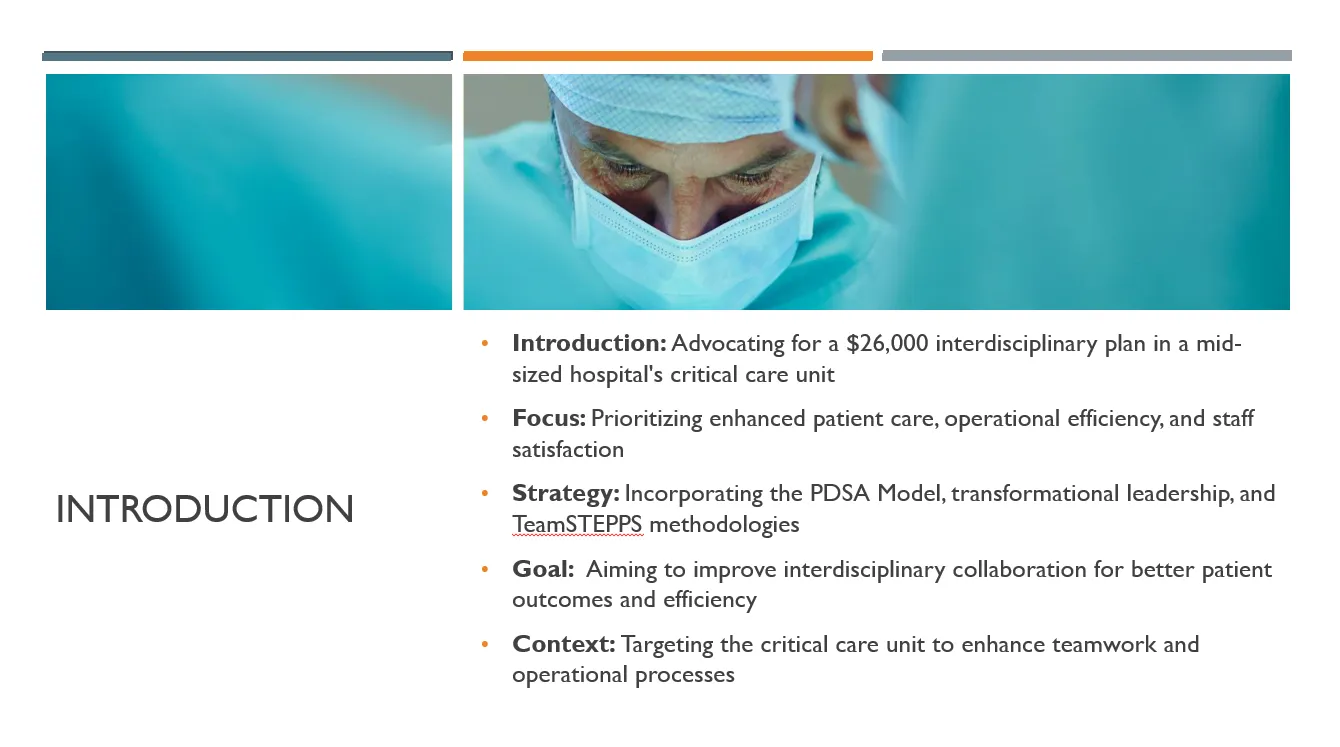
Summarize an evidence-based interdisciplinary plan to address an organizational or patient issue.
Developing the Interdisciplinary Plan
- Outline the components of the interdisciplinary plan.
- Incorporate evidence-based strategies like the PDSA model and TeamSTEPPS.
- Describe how these strategies will address the identified issue.
Example
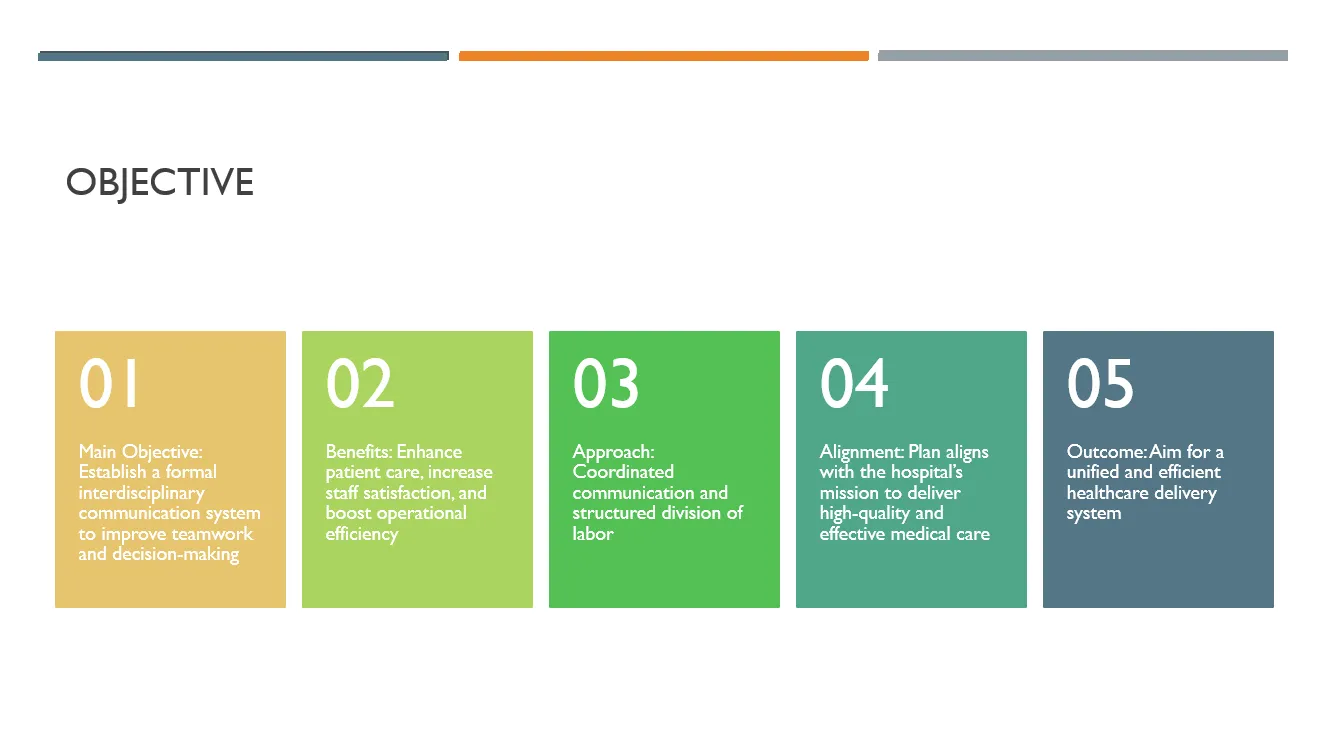
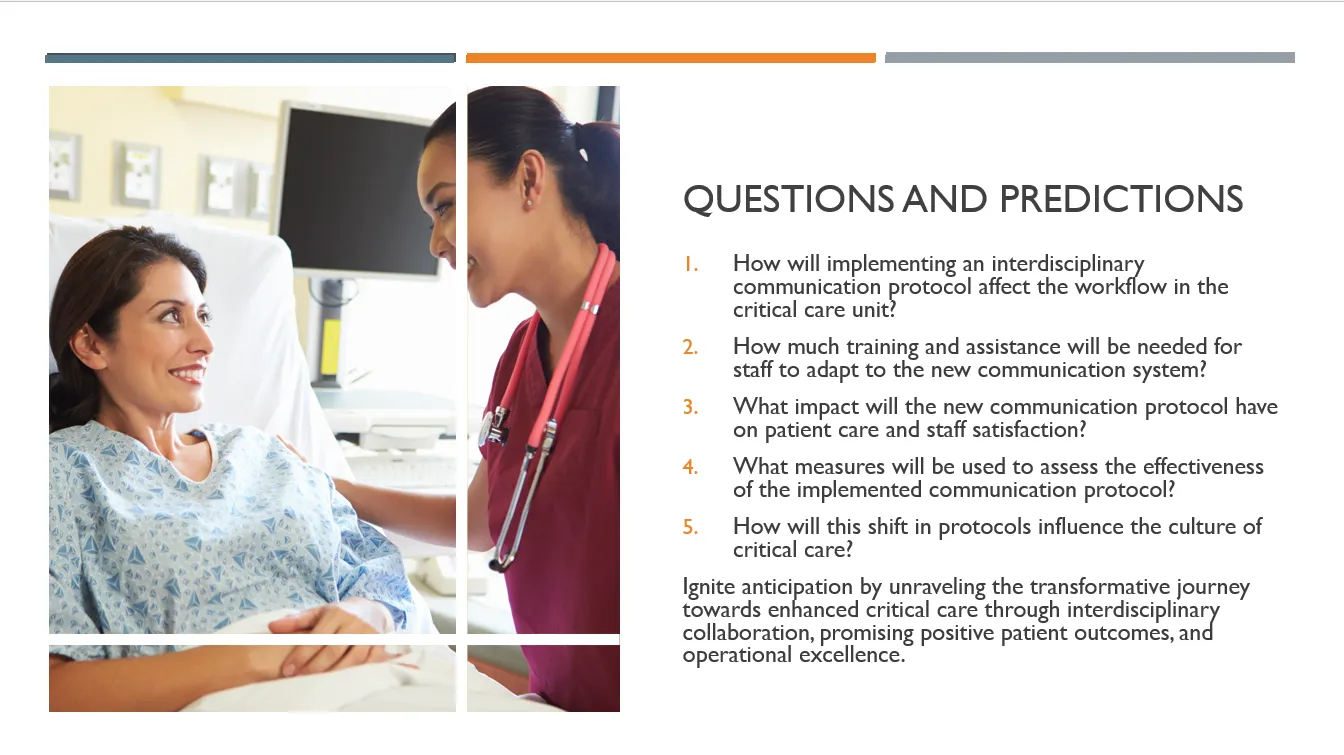
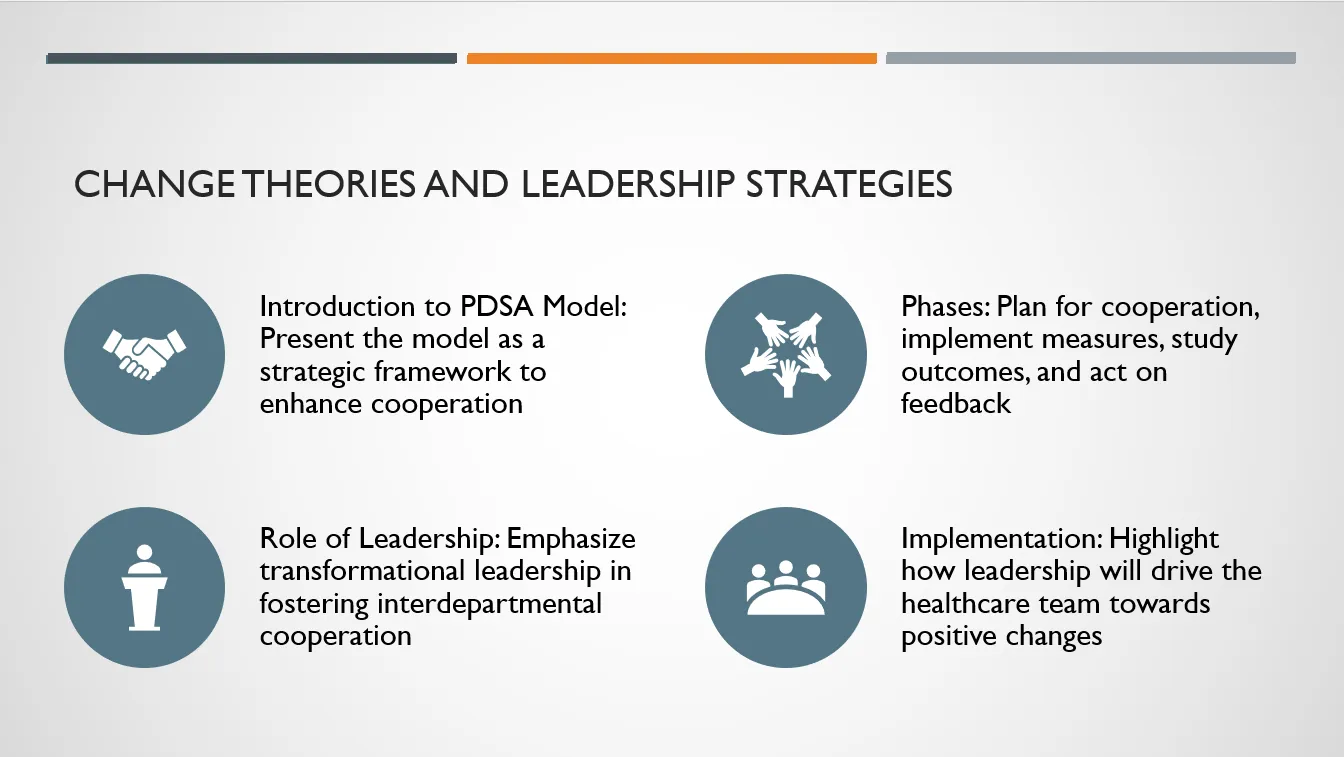
Explain how the interdisciplinary plan could be implemented and how the human and financial resources would be managed.
Implementation and Resource Management
- Detail the steps of implementation using the PDSA model.
- Discuss resource allocation, including staffing and budget requirements.
- Explain managerial roles and responsibilities in resource management.
Example
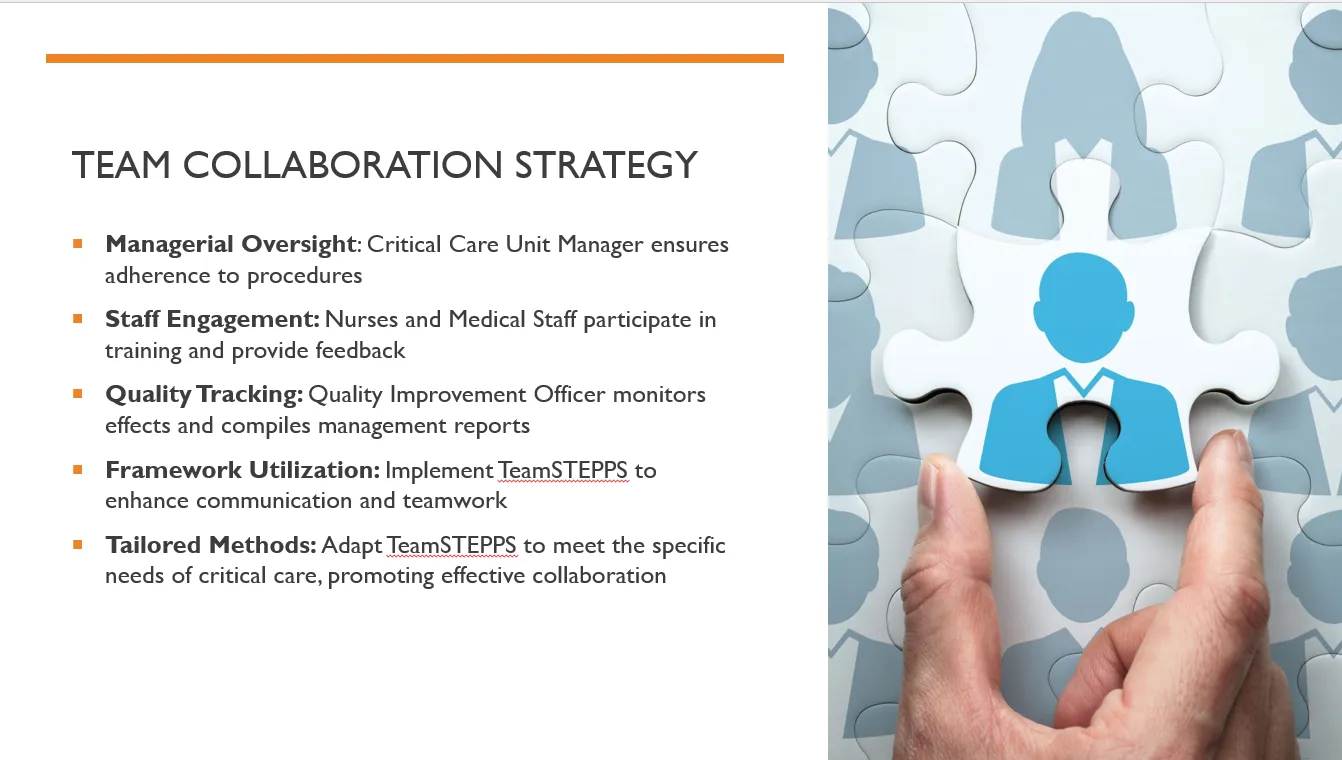
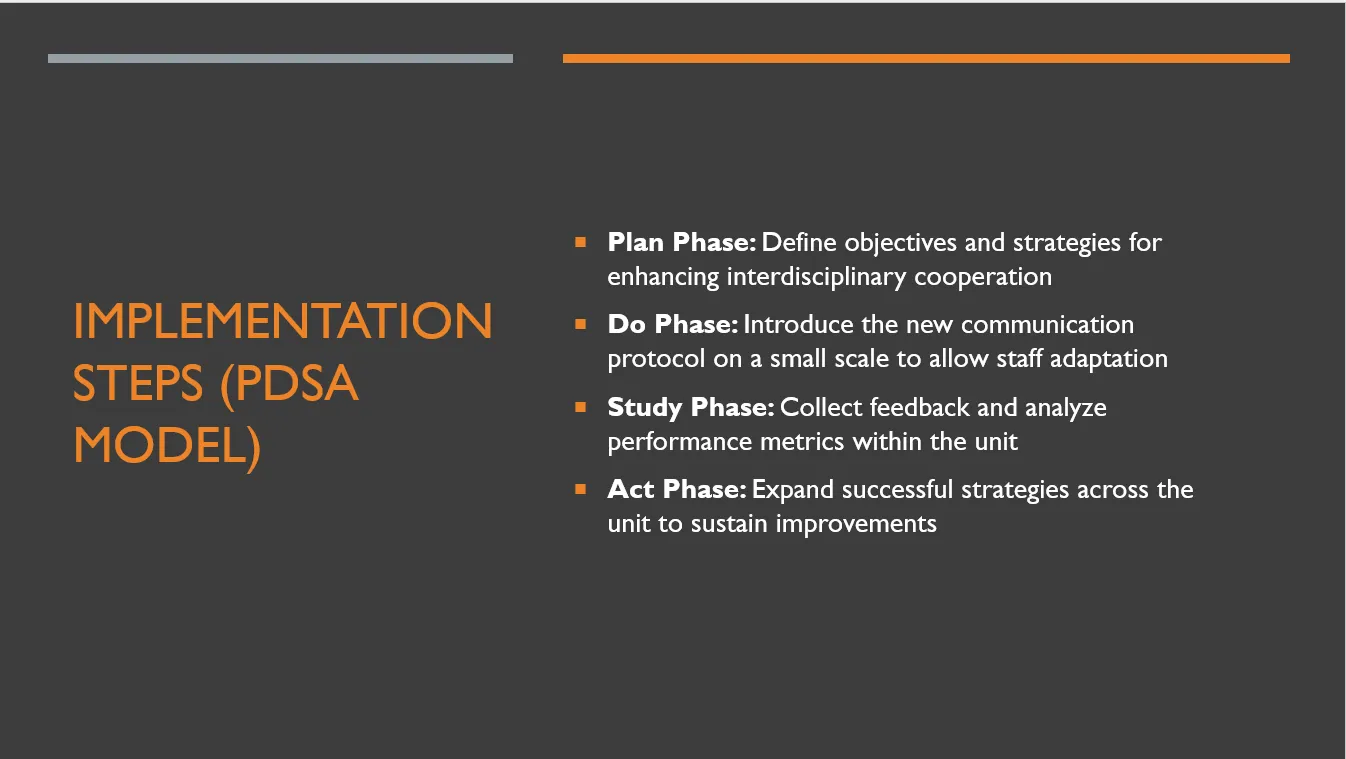
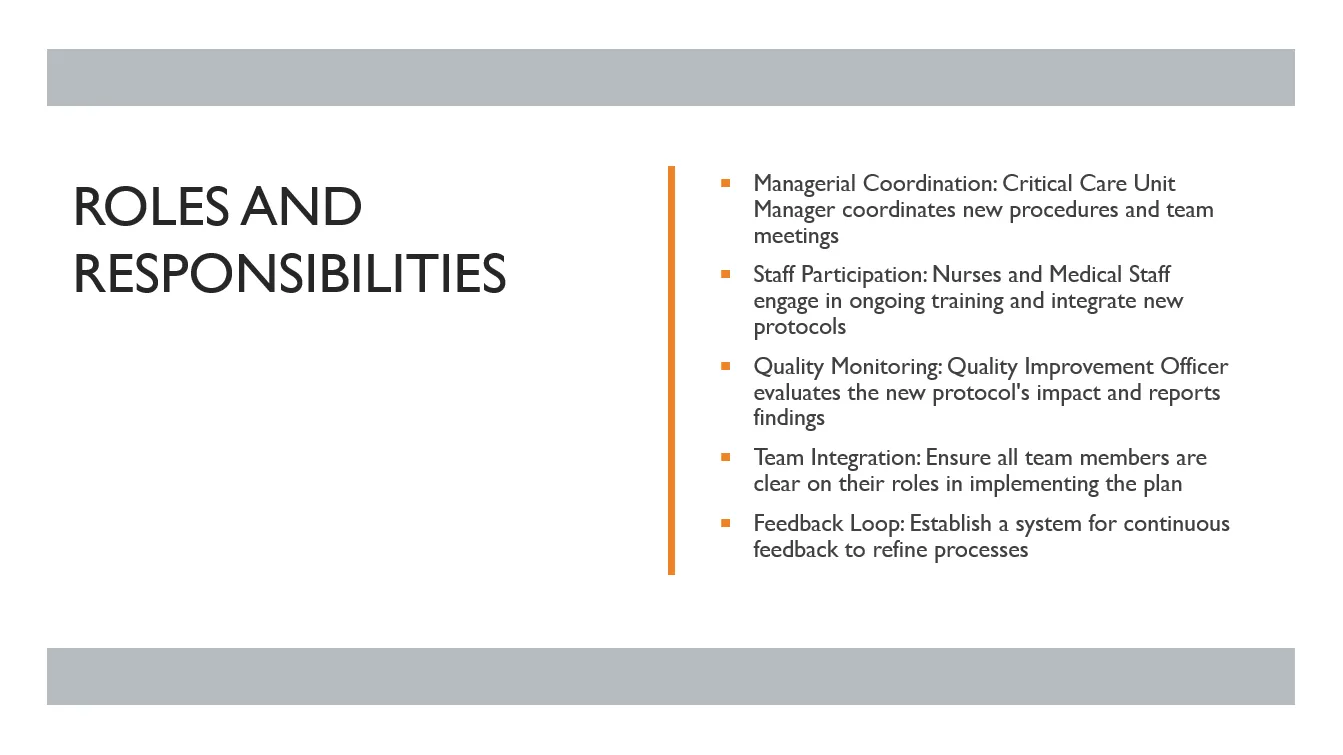
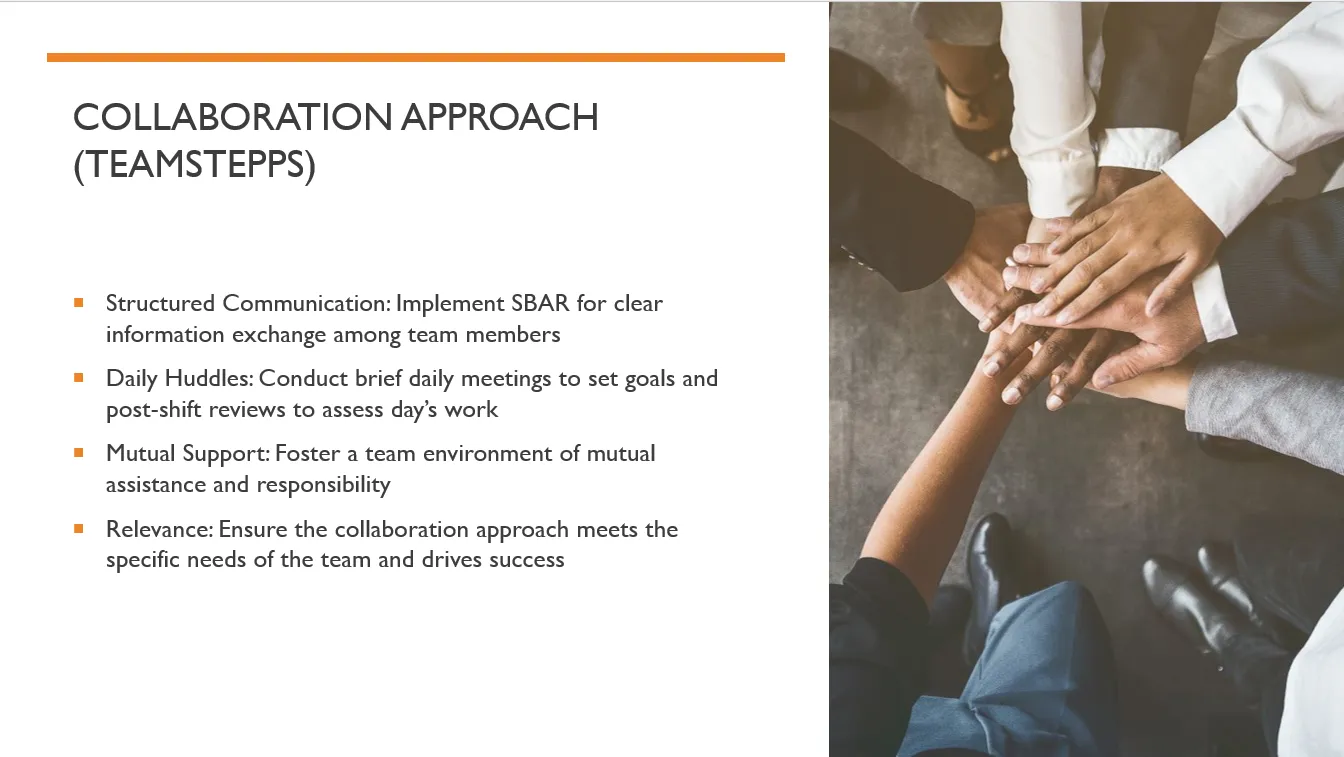
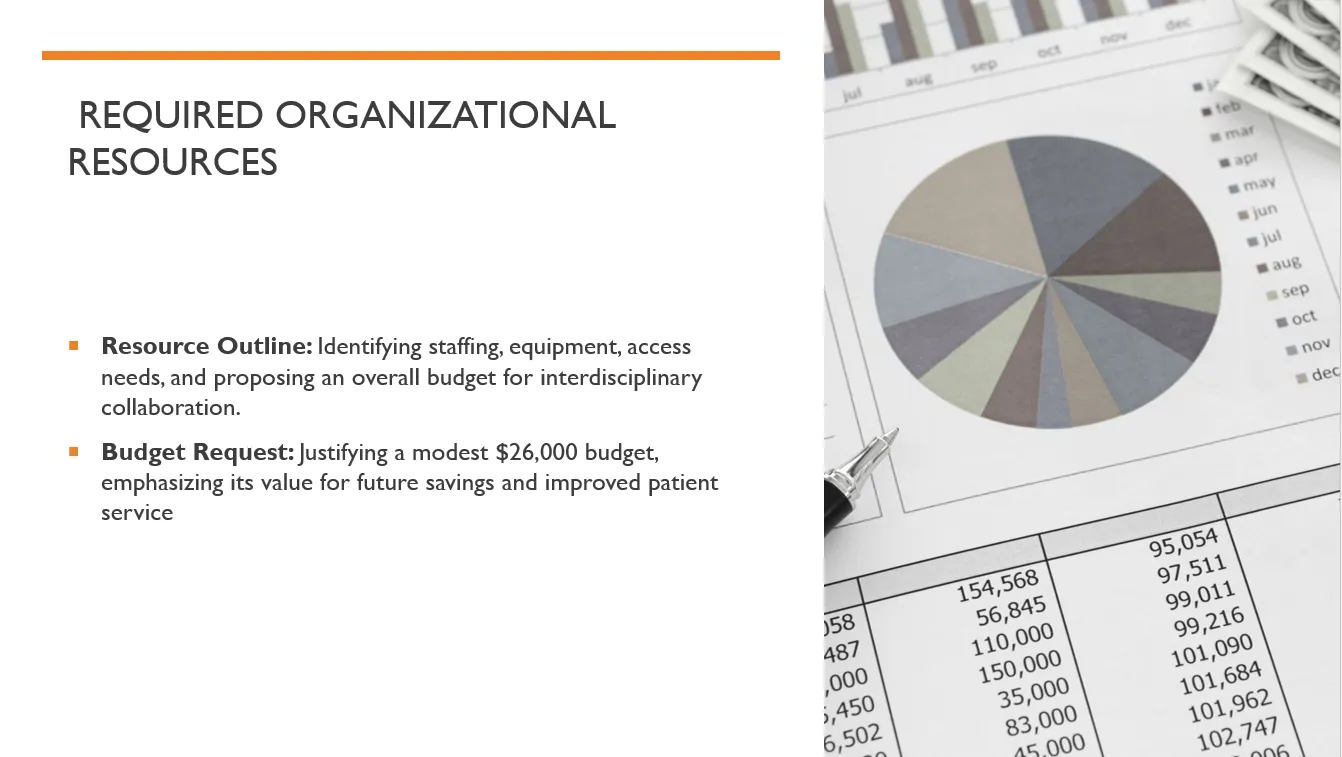
Propose evidence-based criteria that could be used to evaluate the degree to which the project was successful in achieving the improvement goal.
Evaluating the Effectiveness of the Plan
- Define specific criteria for measuring the success of the implementation.
- Include metrics related to patient care, staff satisfaction, and operational efficiency.
- Discuss how feedback will be collected and analyzed.
Example
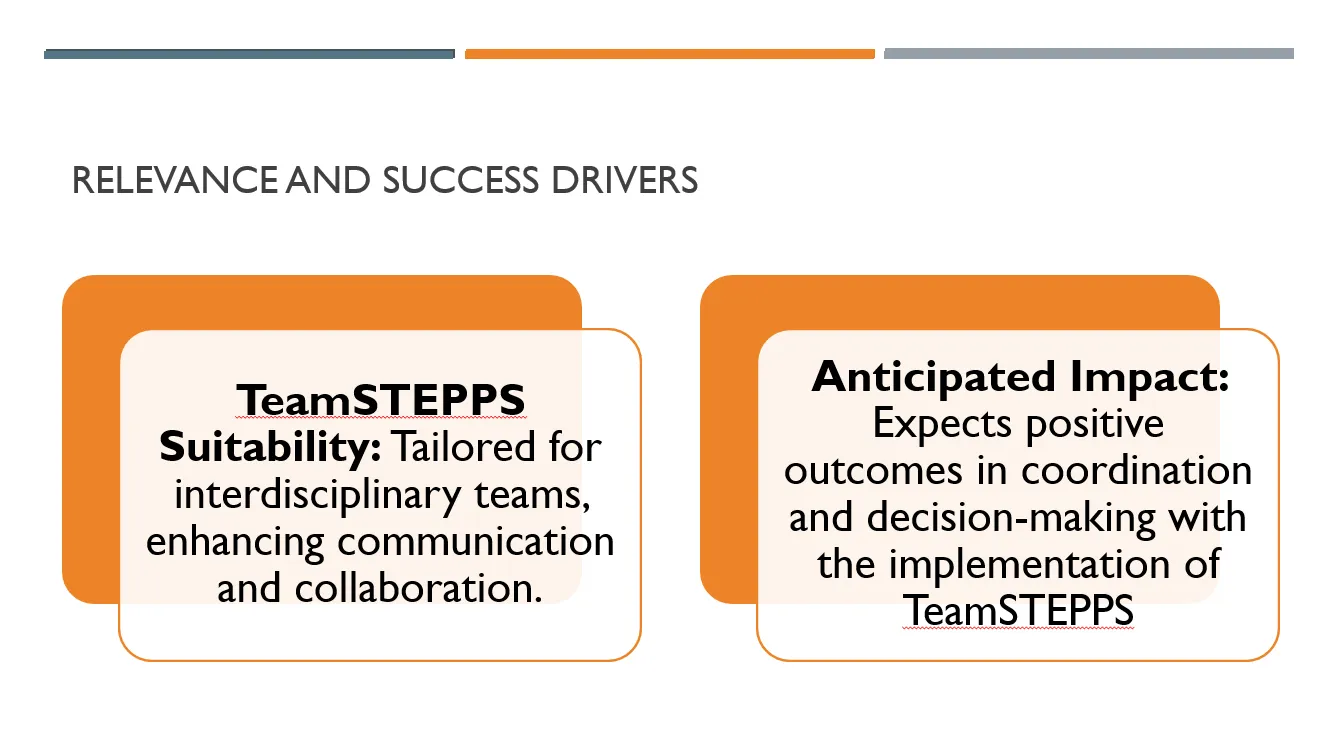
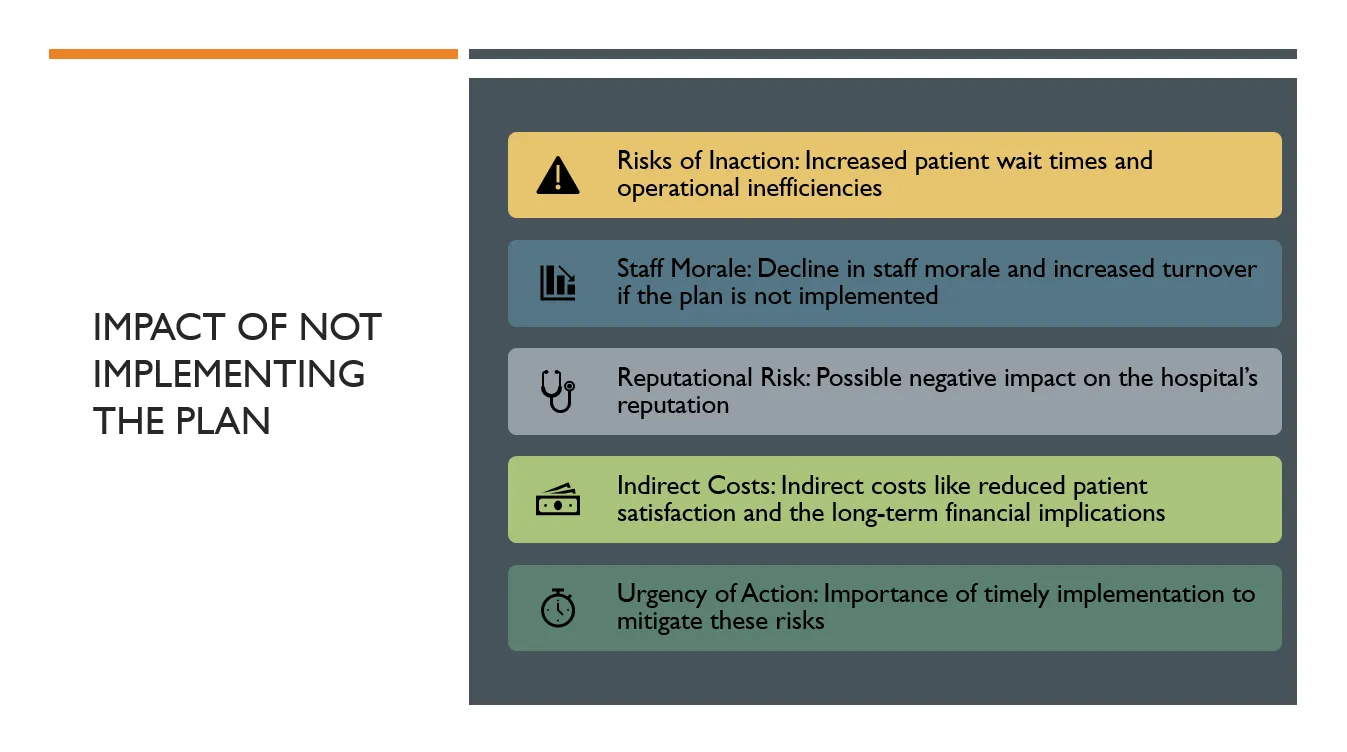
Communicate the PowerPoint presentation of the interdisciplinary improvement plan to stakeholders in a professional manner, with writing that is clear, logically organized, and respectful with correct grammar and spelling using current APA style.
Communicating the Plan to Stakeholders
- Ensure all slides are clear, concise, and contain necessary presenter notes.
- Check that all text is grammatically correct and spelling is accurate.
- Verify APA formatting for in-text citations and references.
Example
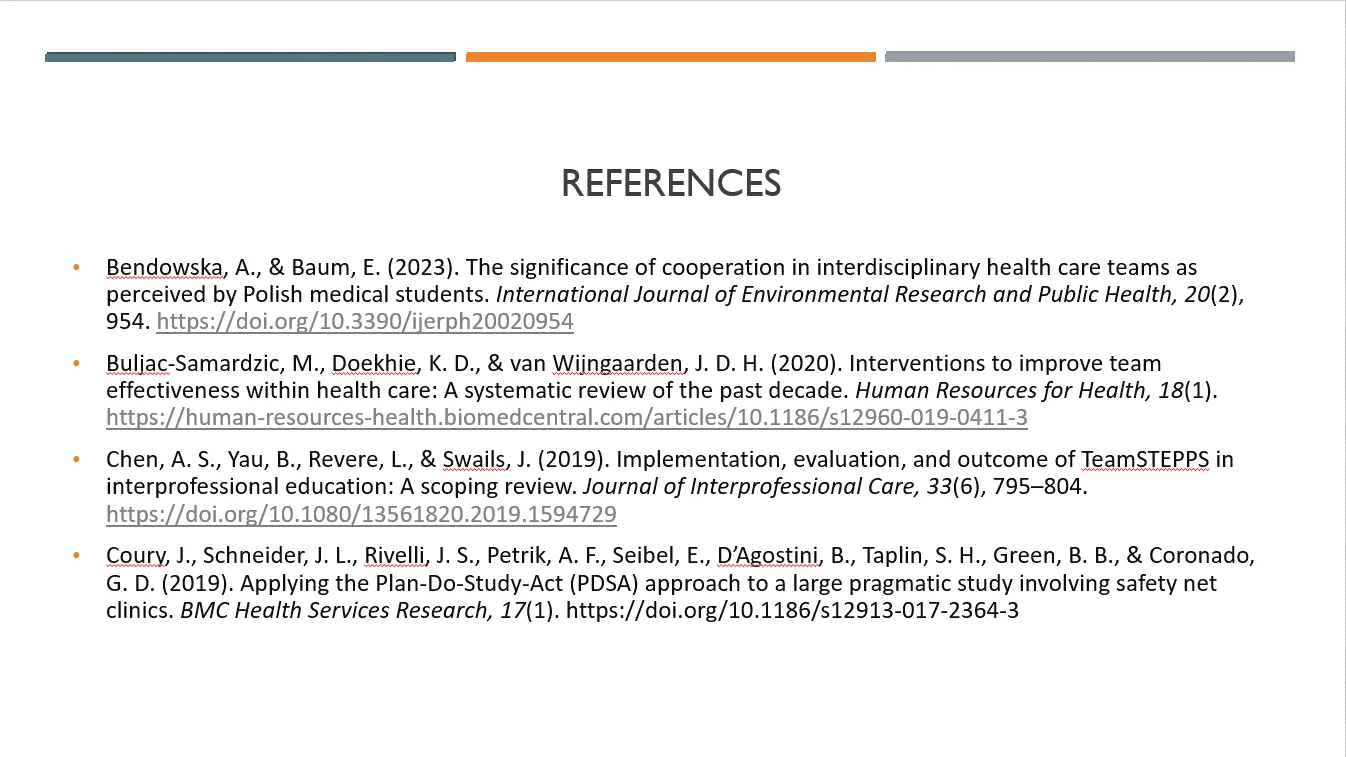
Closing
In the NURS-FPX4010 Assessment 4 Stakeholder Presentation, the articulation and delivery of a well-structured interdisciplinary improvement plan are crucial in achieving significant advancements in healthcare settings. By harnessing the power of collaborative approaches, robust evidence-based methodologies, and clear communication, nurse leaders are equipped to drive substantial changes. Always aim for precision, clarity, and rigorous adherence to professional standards in your presentations to ensure they resonate with stakeholders and achieve the desired impact. Let NURS-FPX4010 Assessment 4: Stakeholder Presentation guide be a cornerstone in your continuous professional development, helping you to effectively convey critical healthcare initiatives within your organization.



